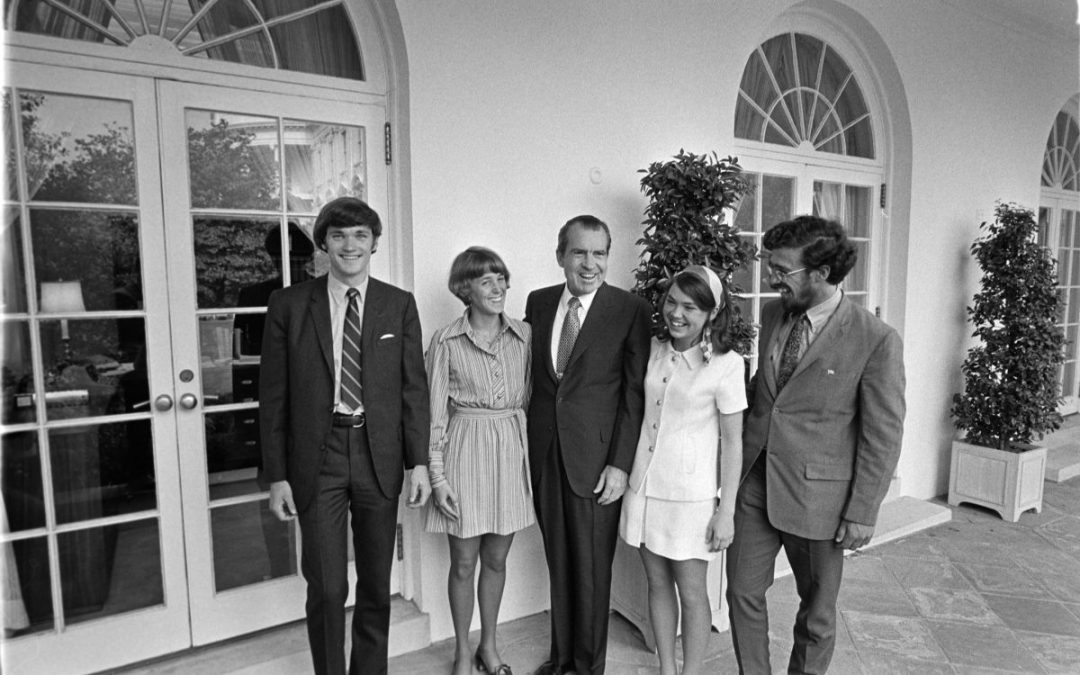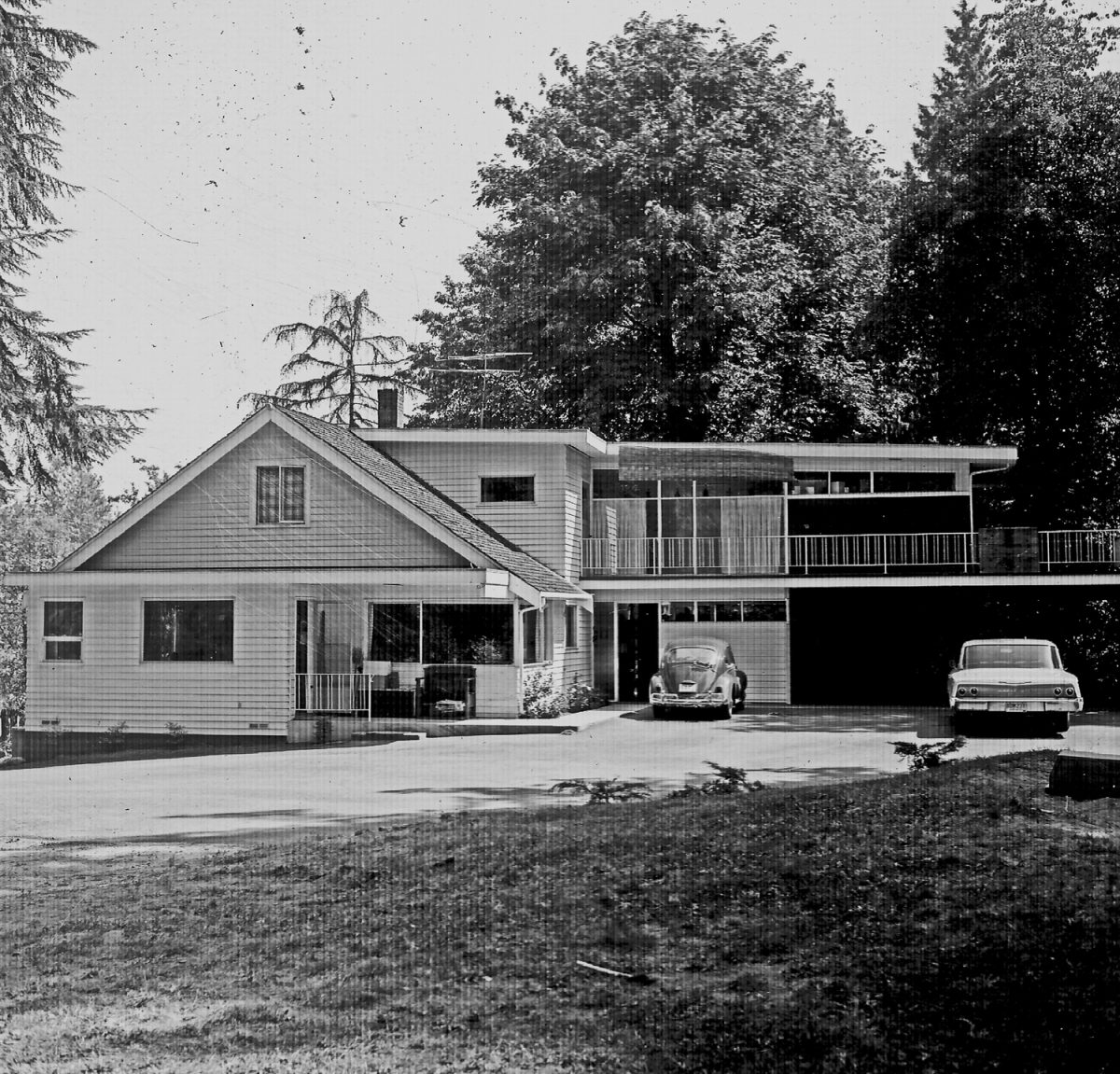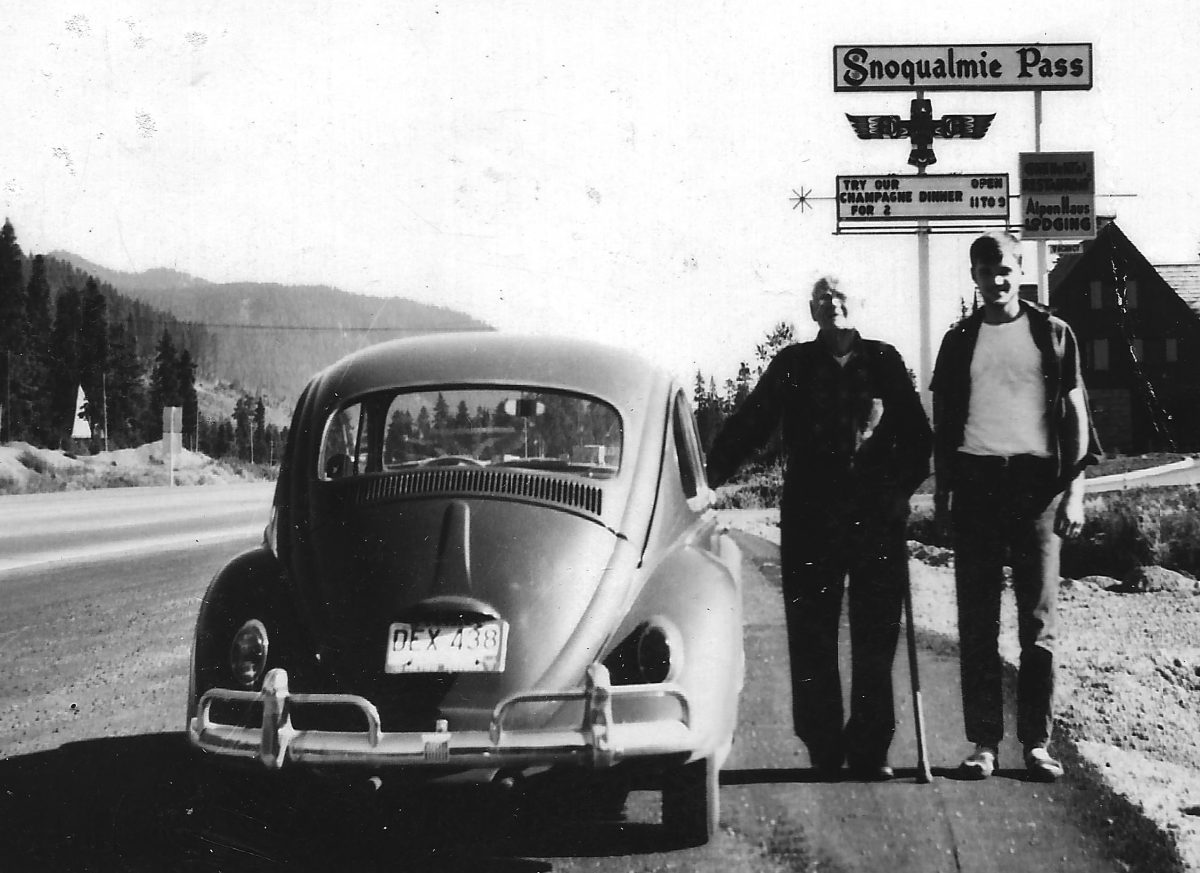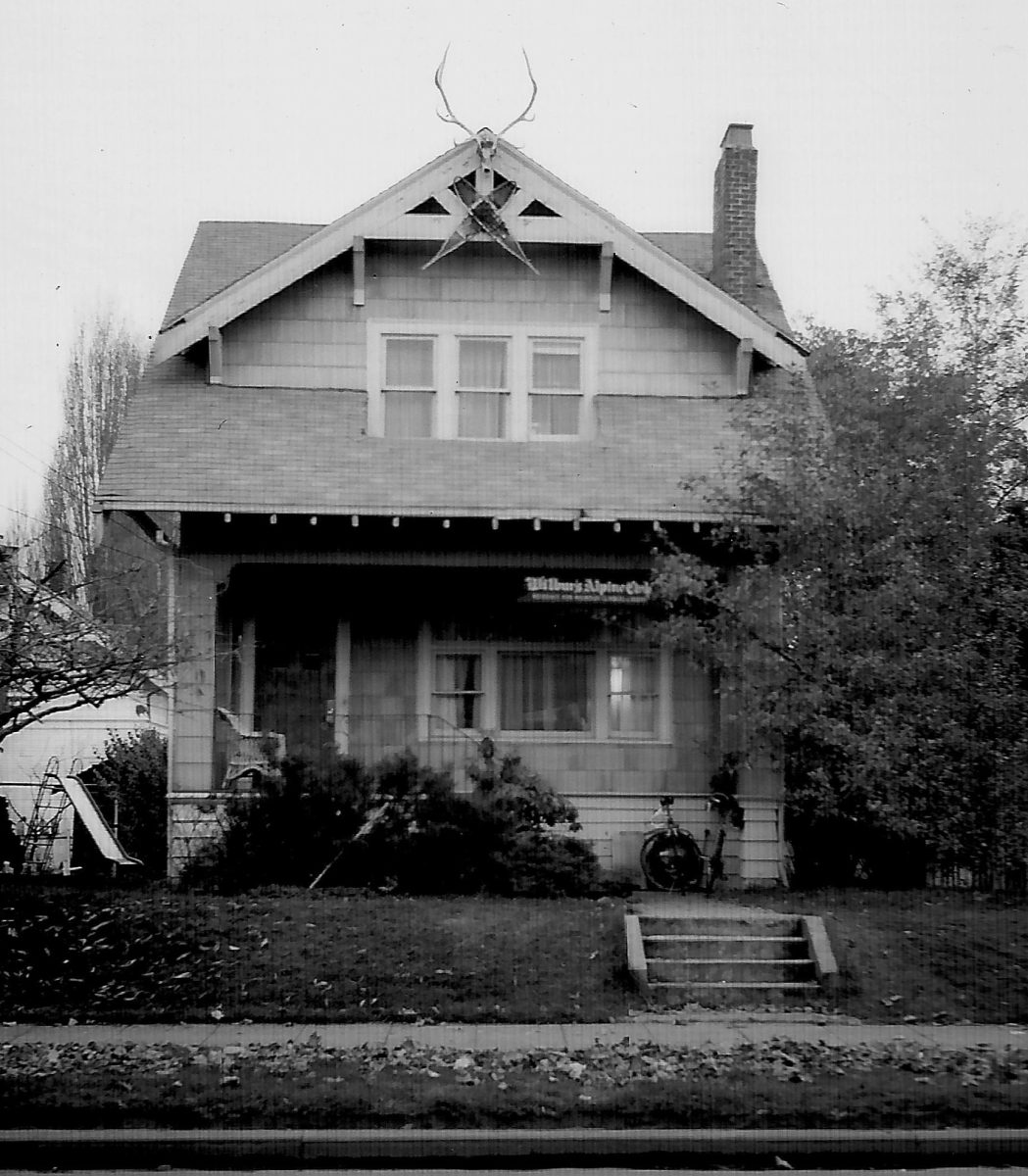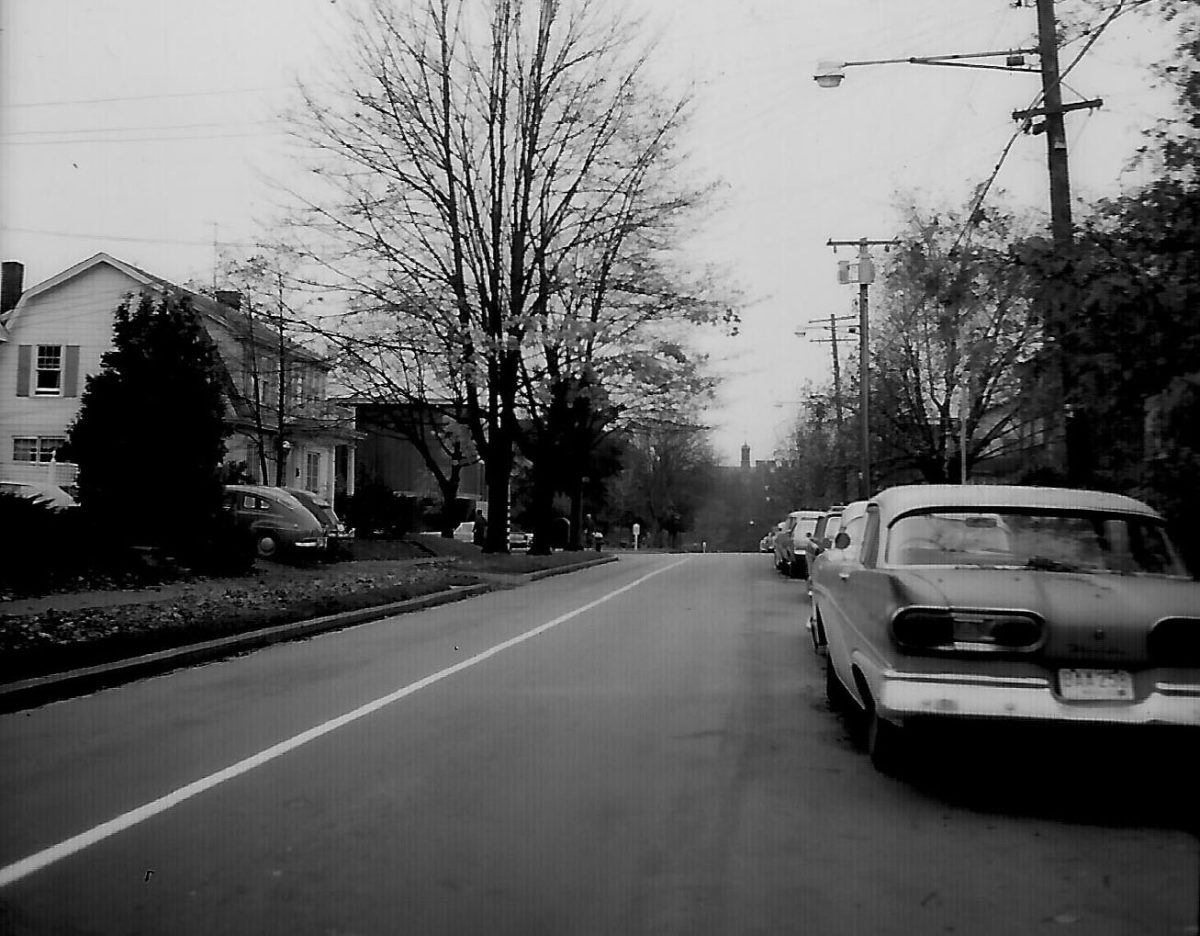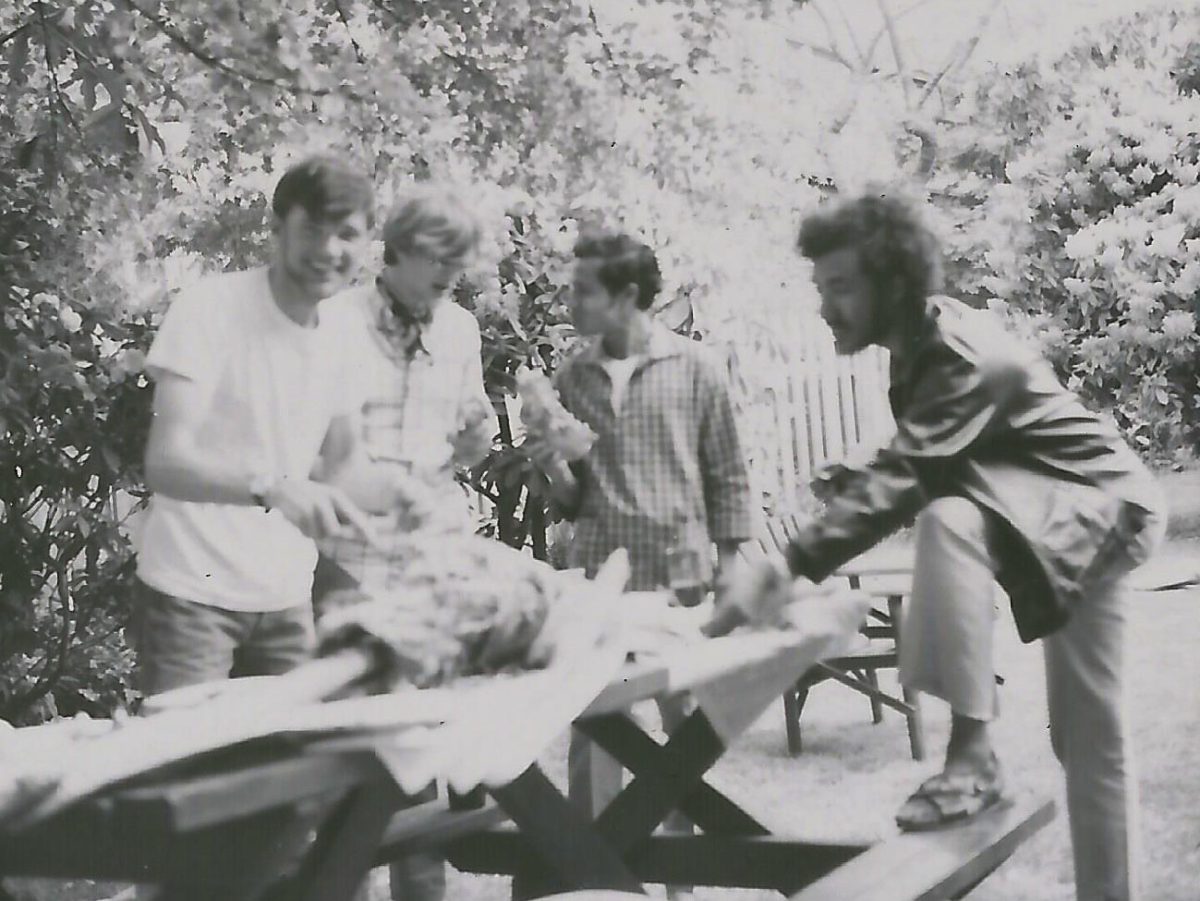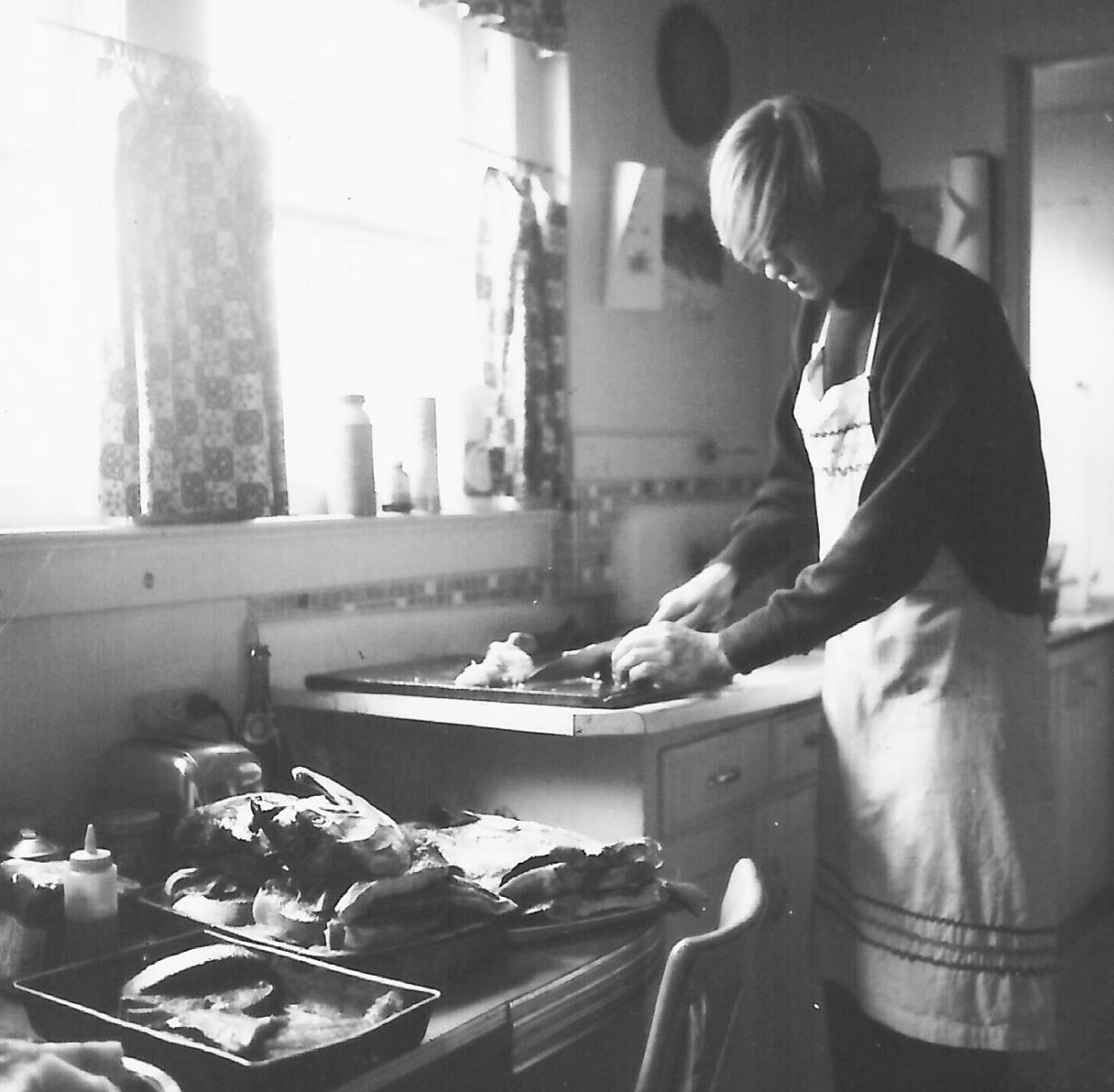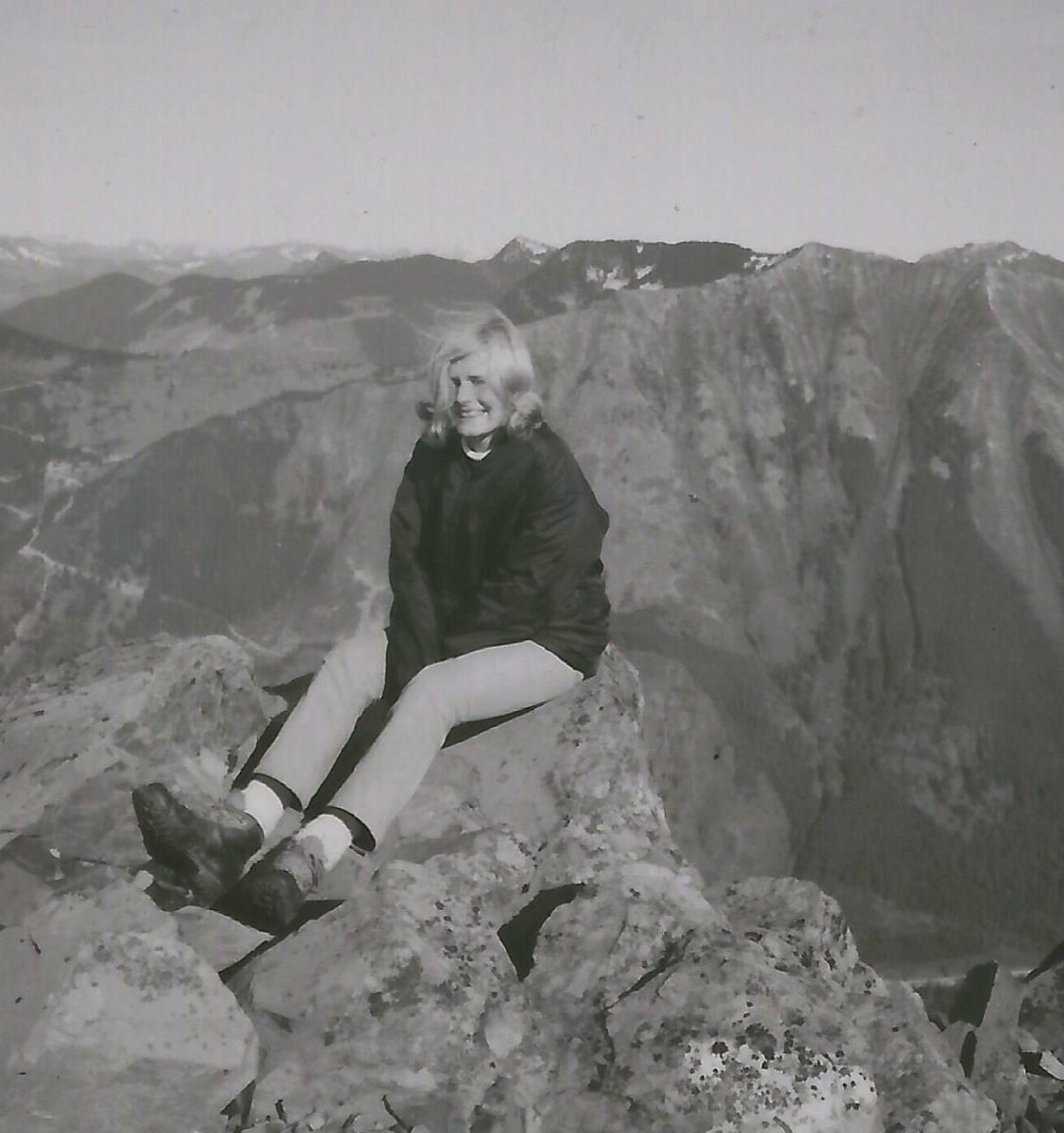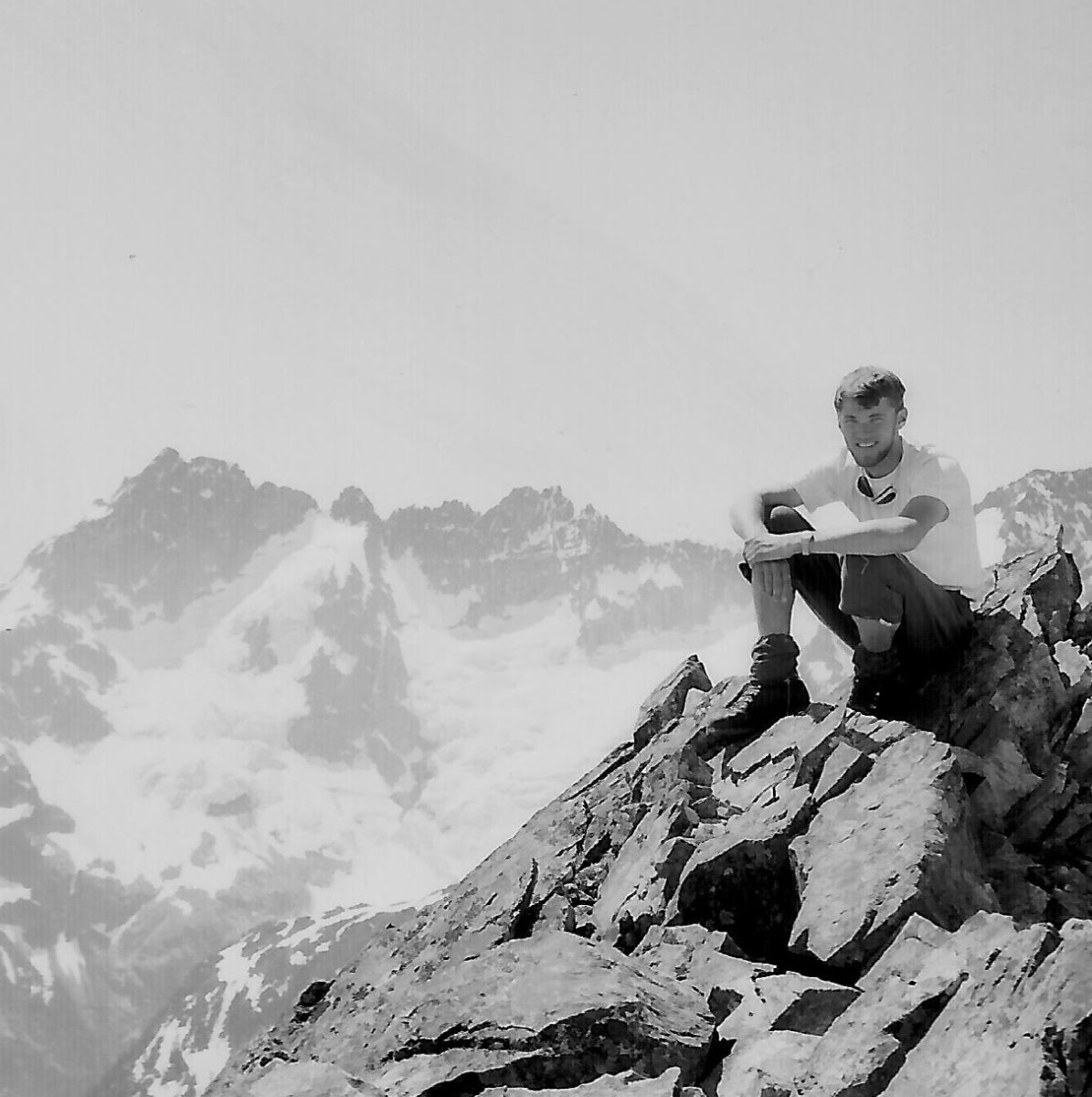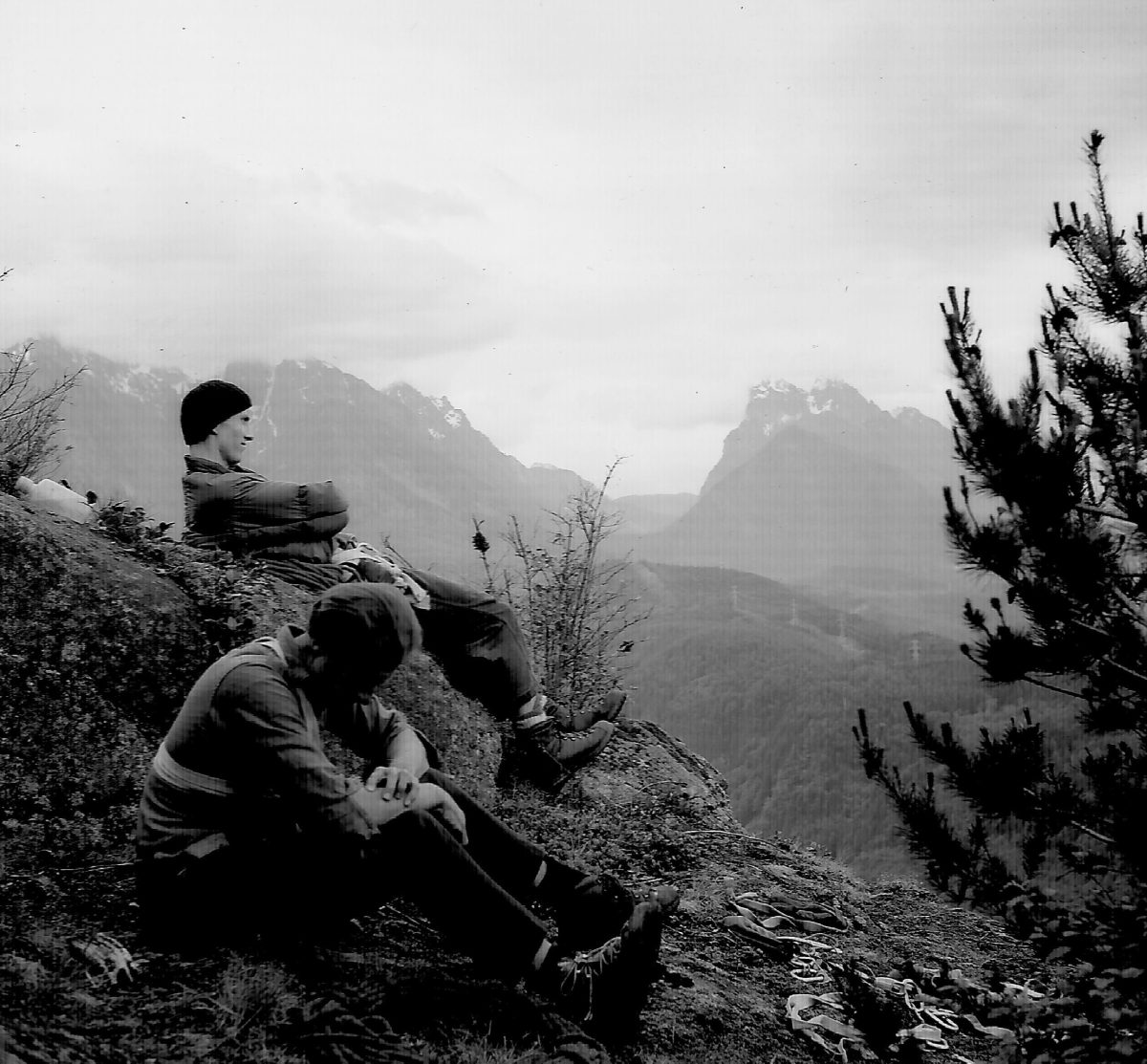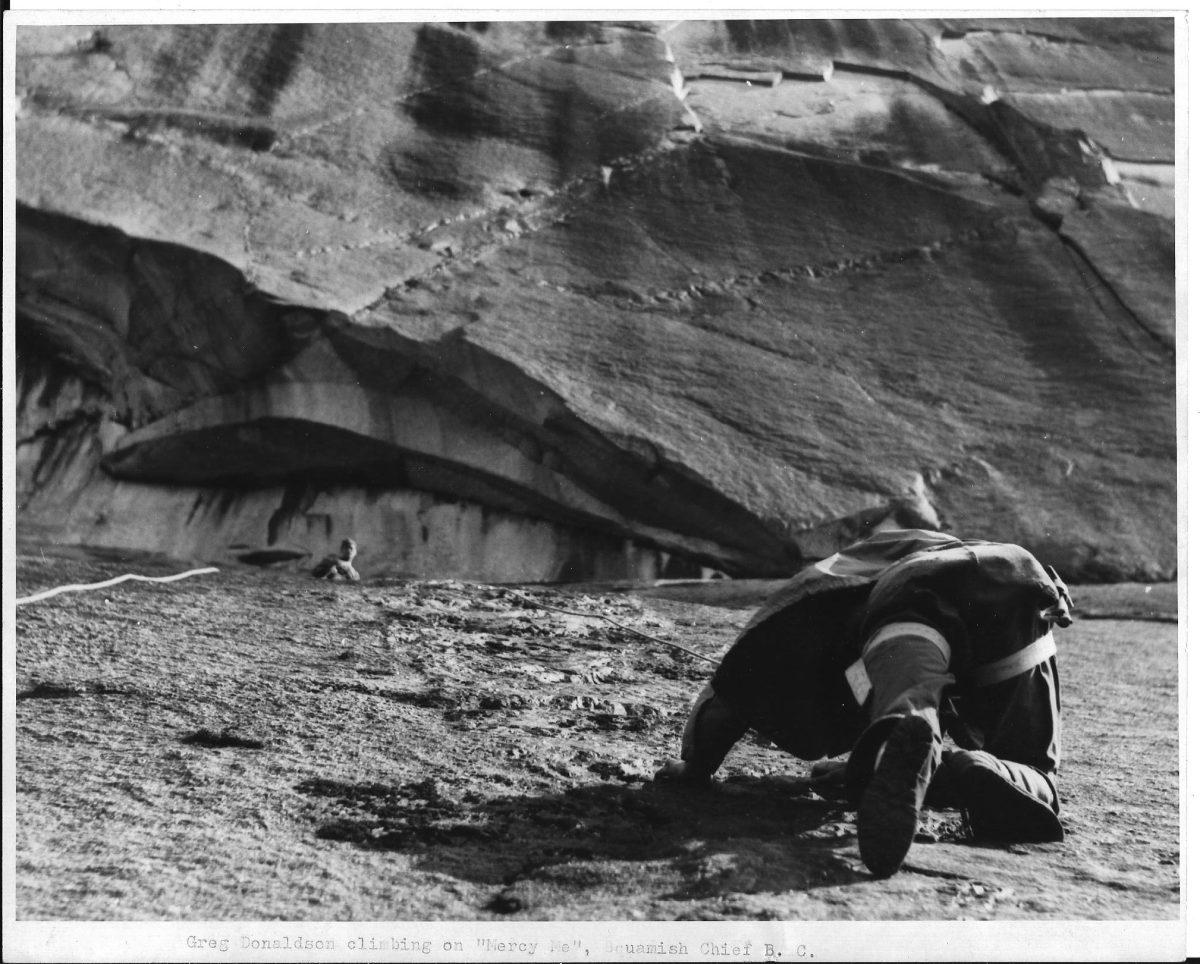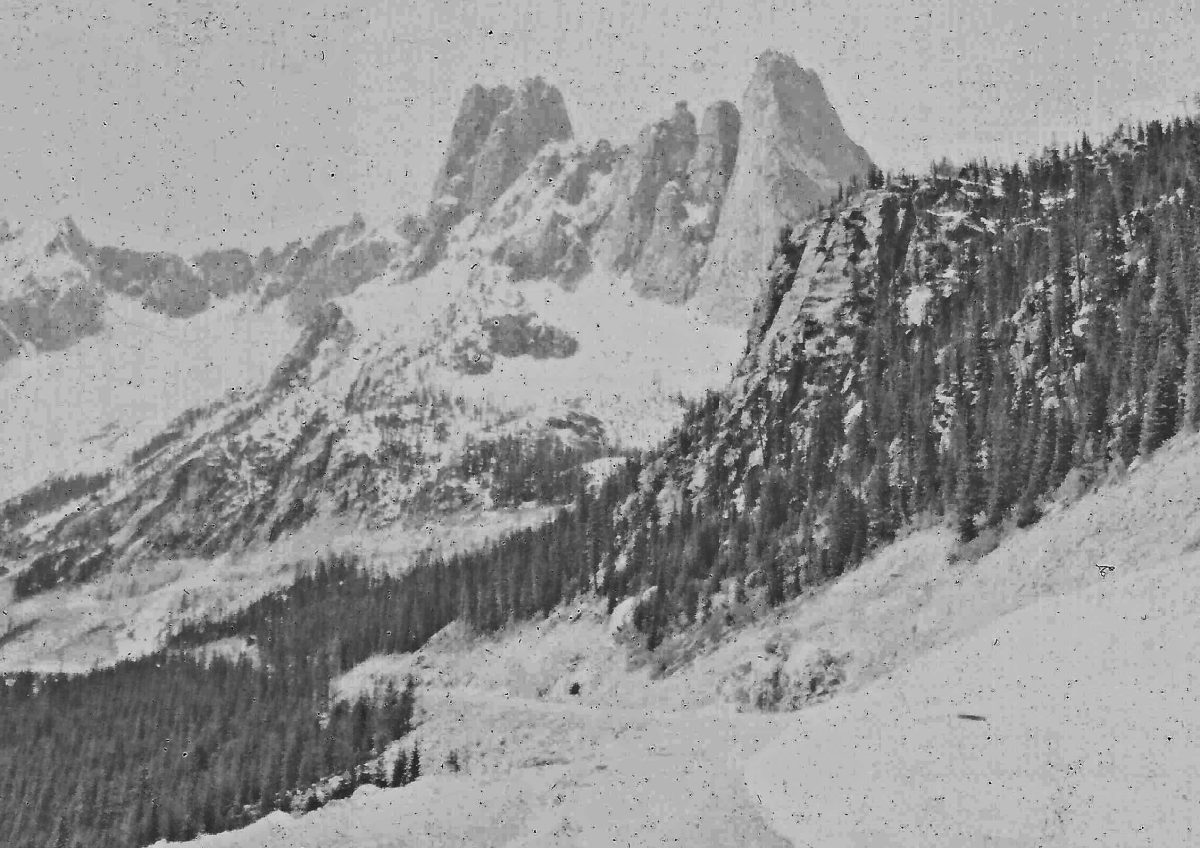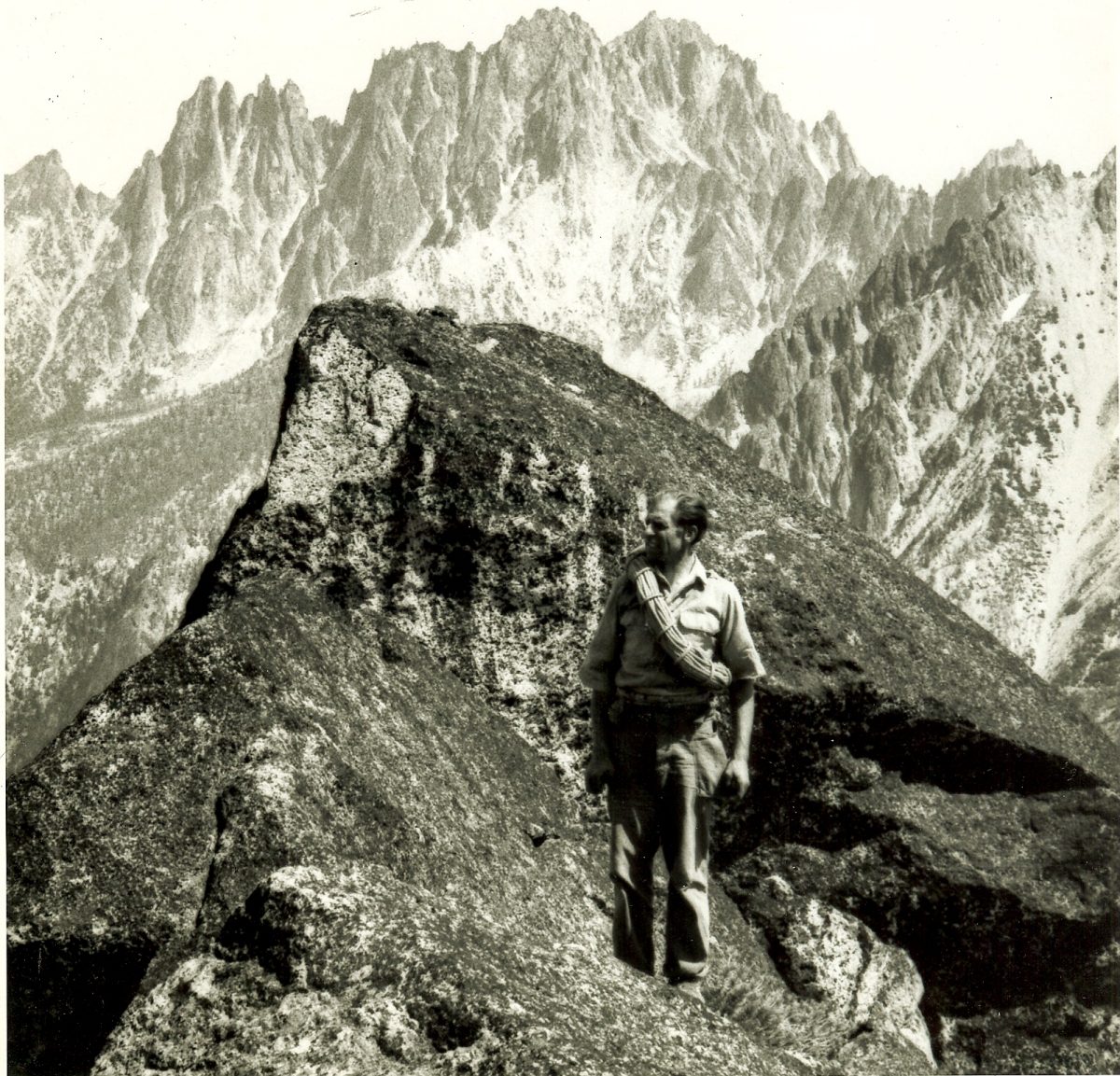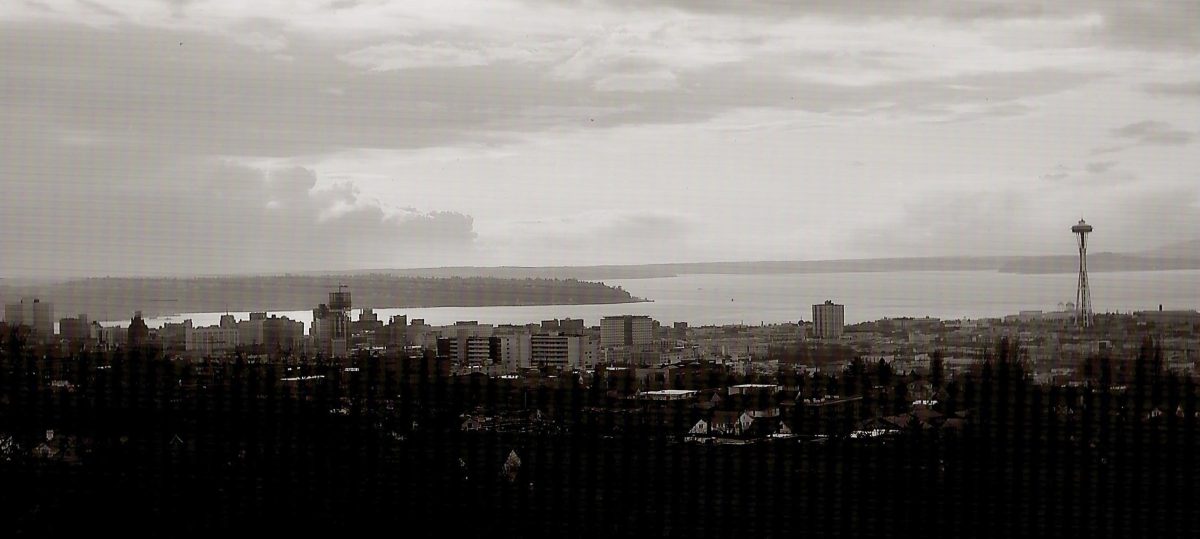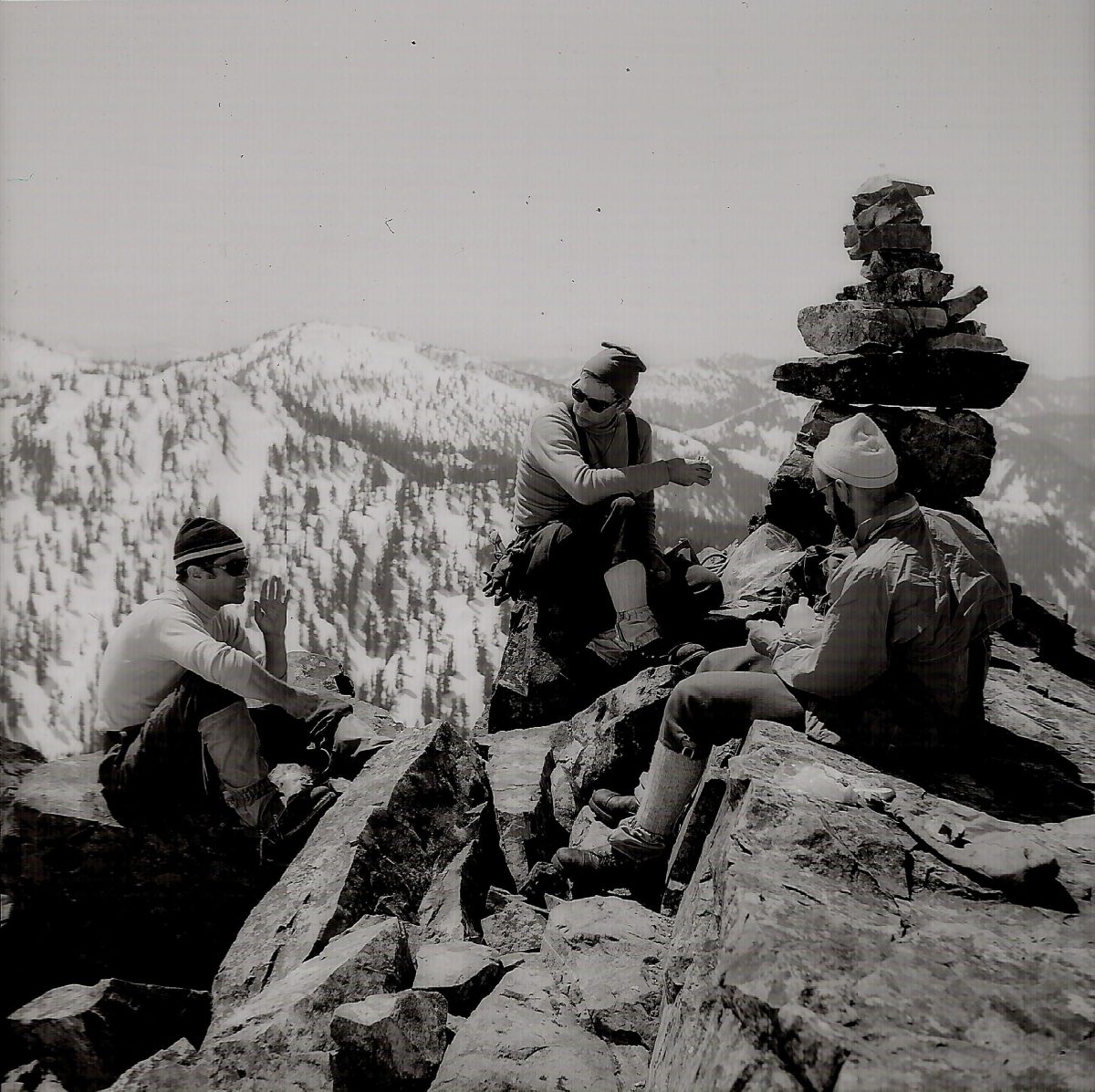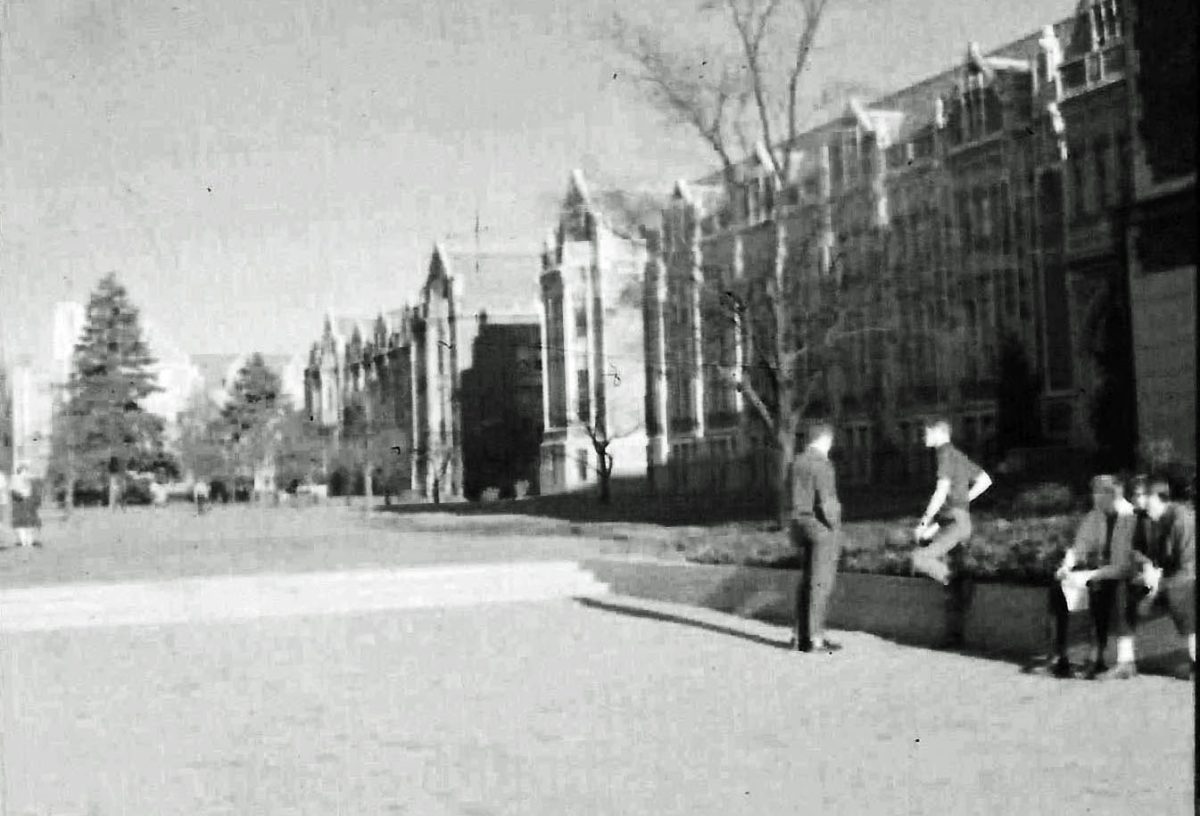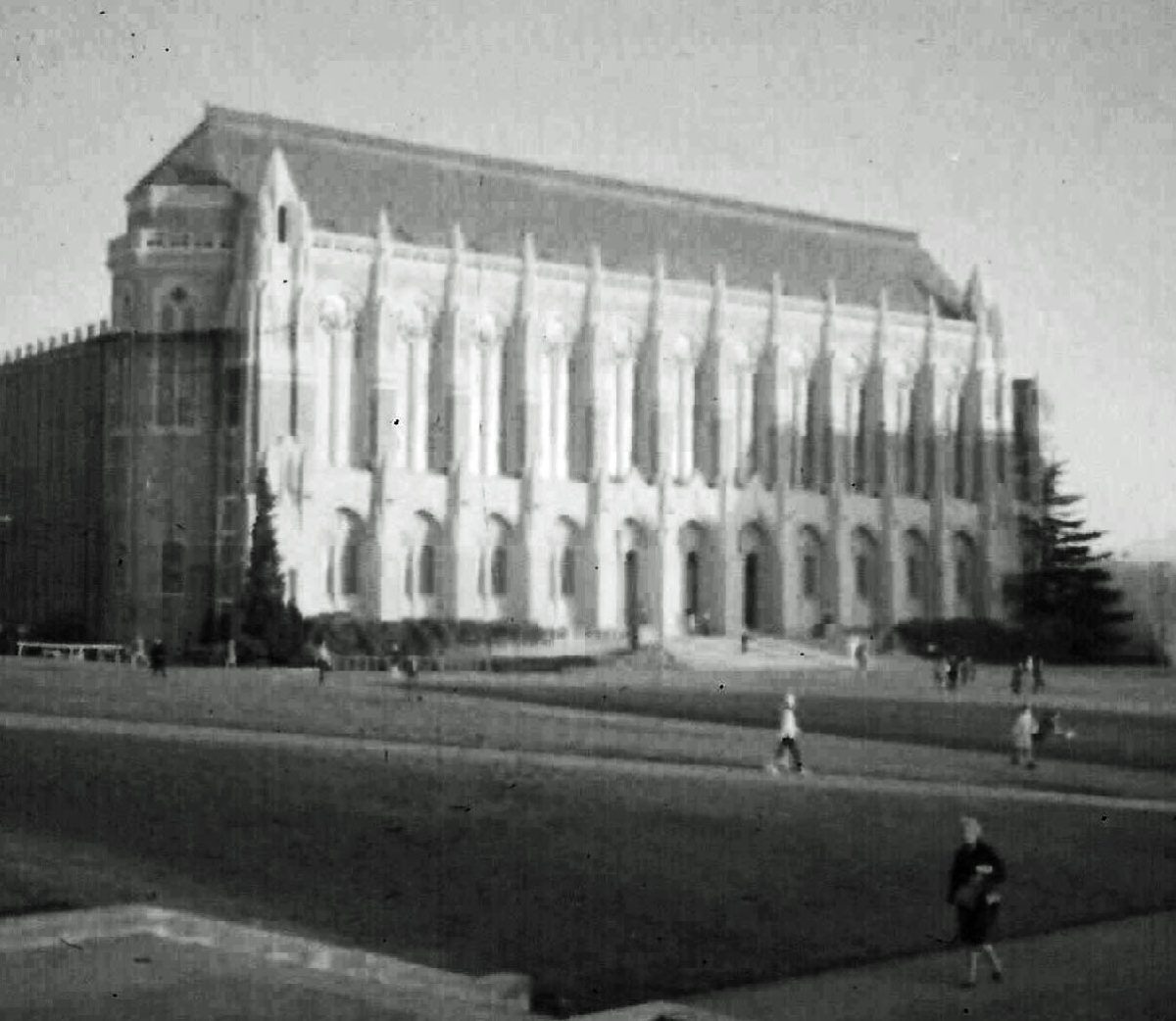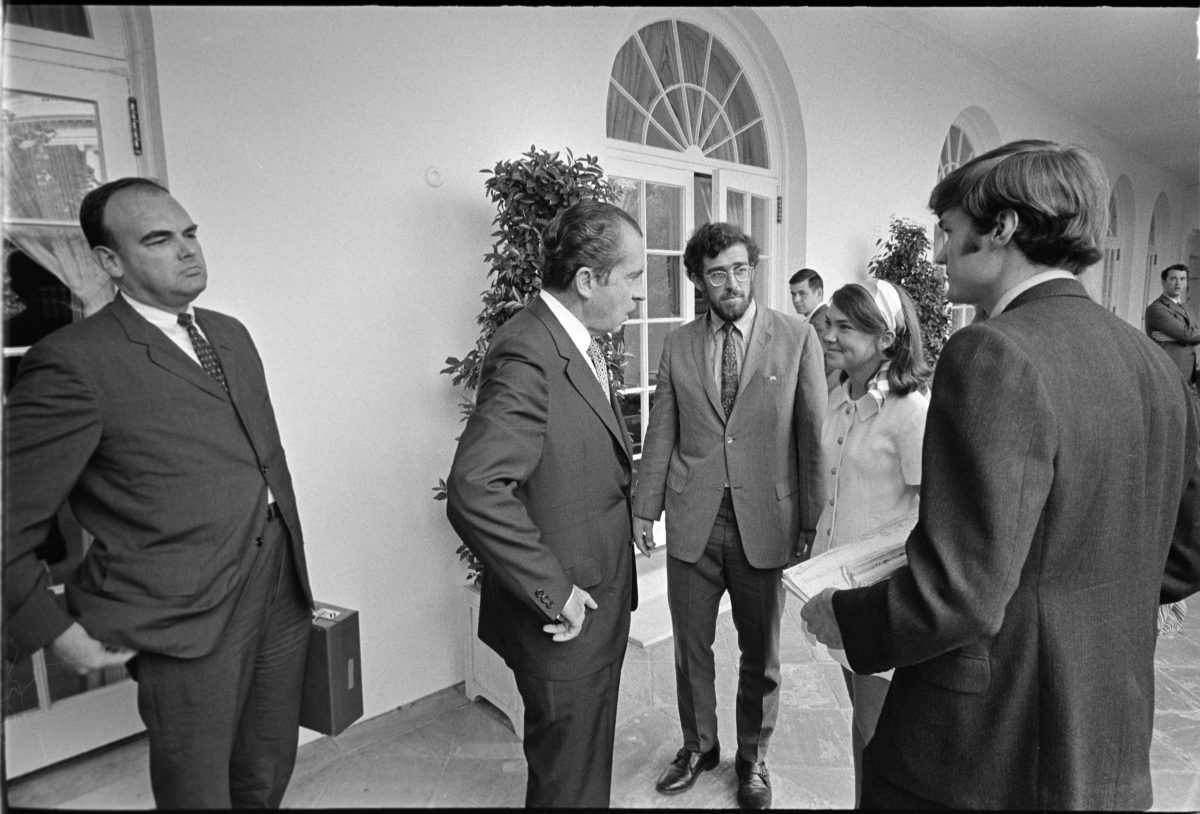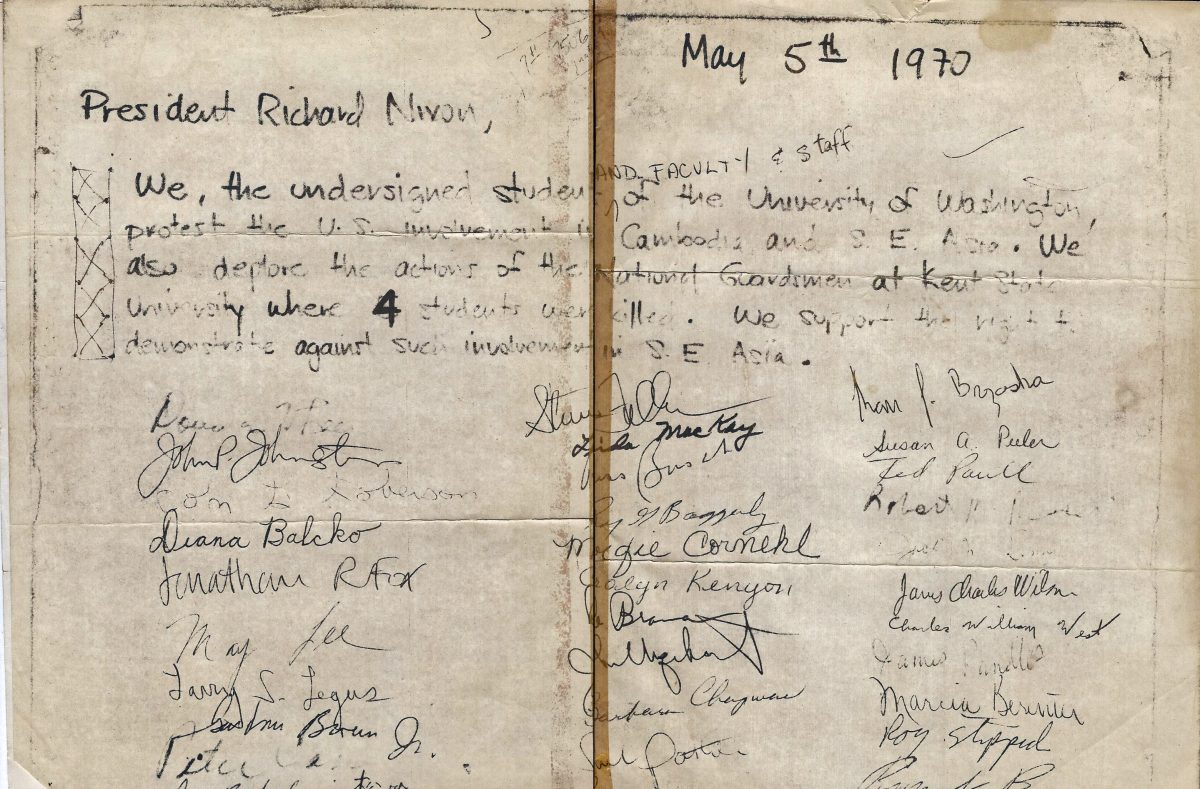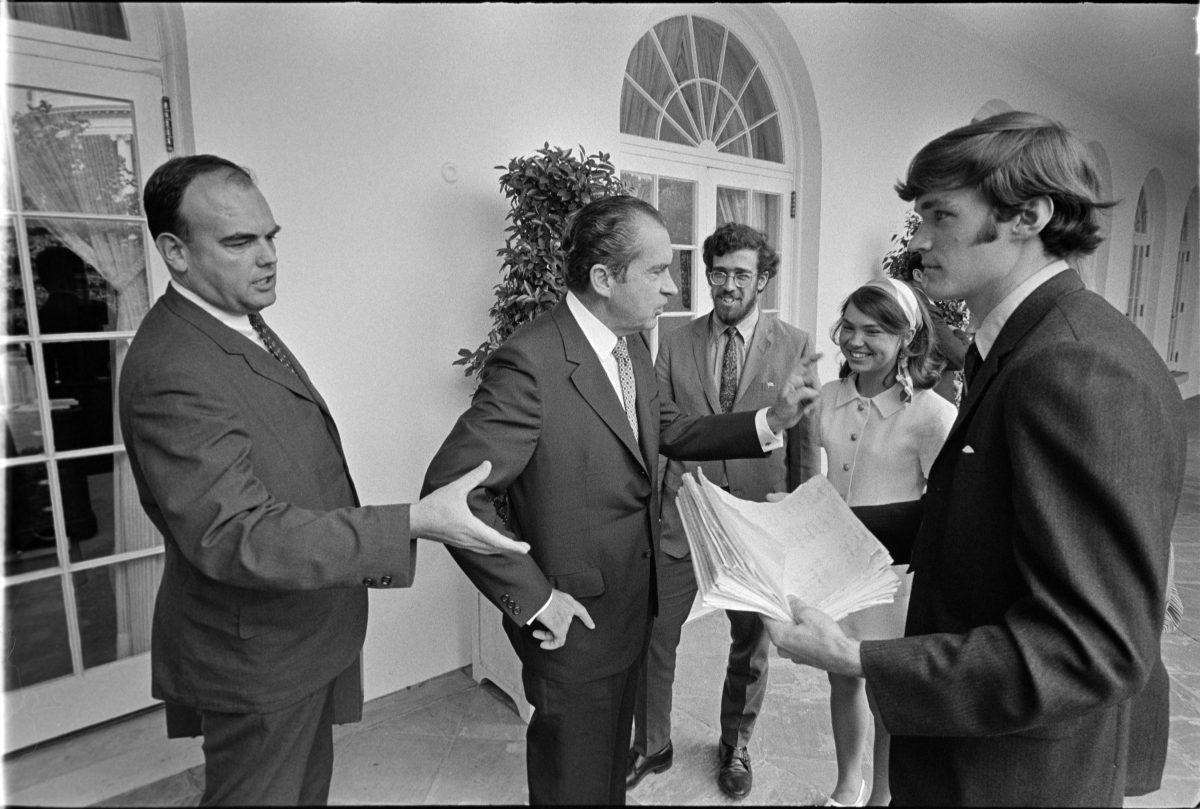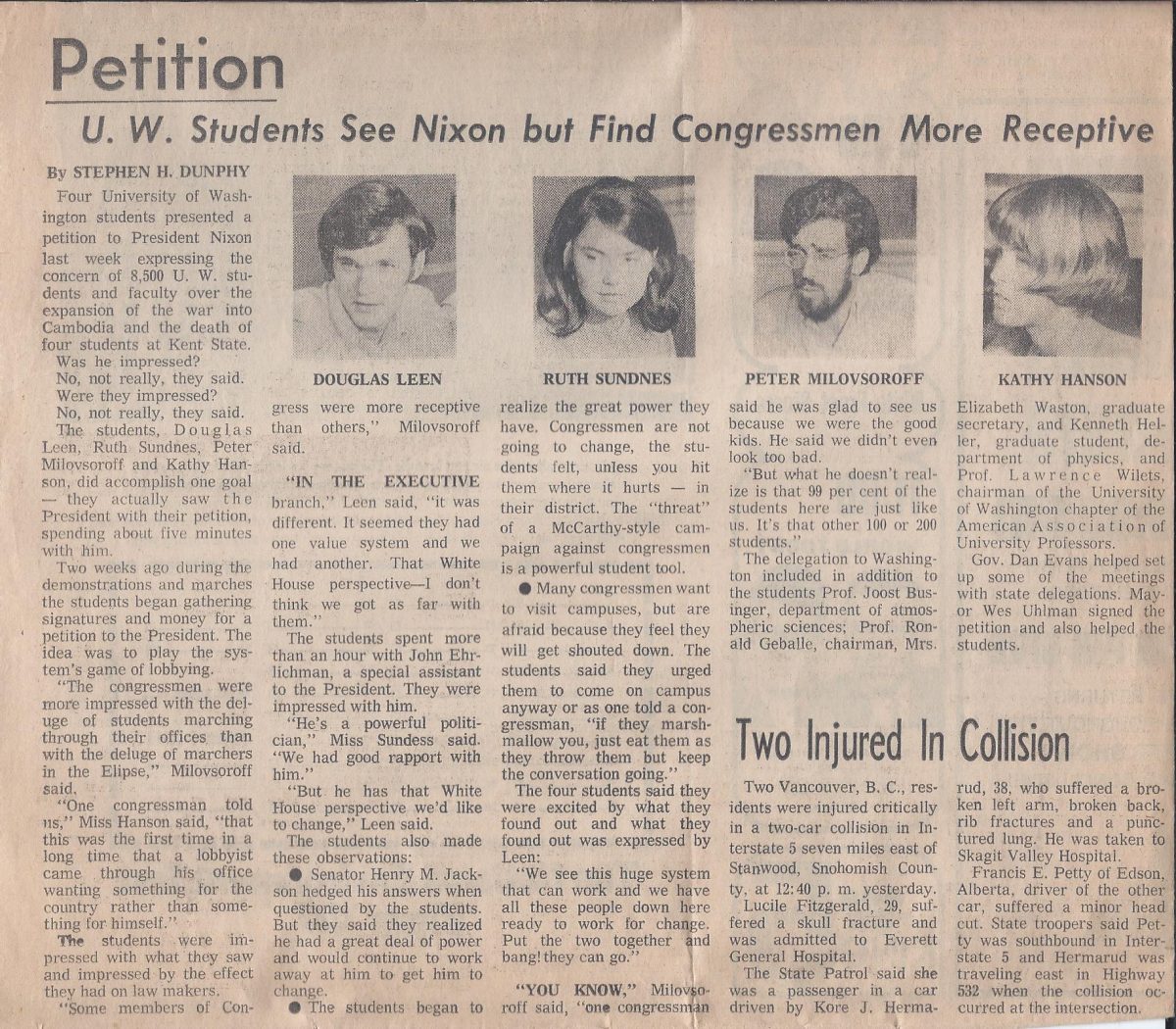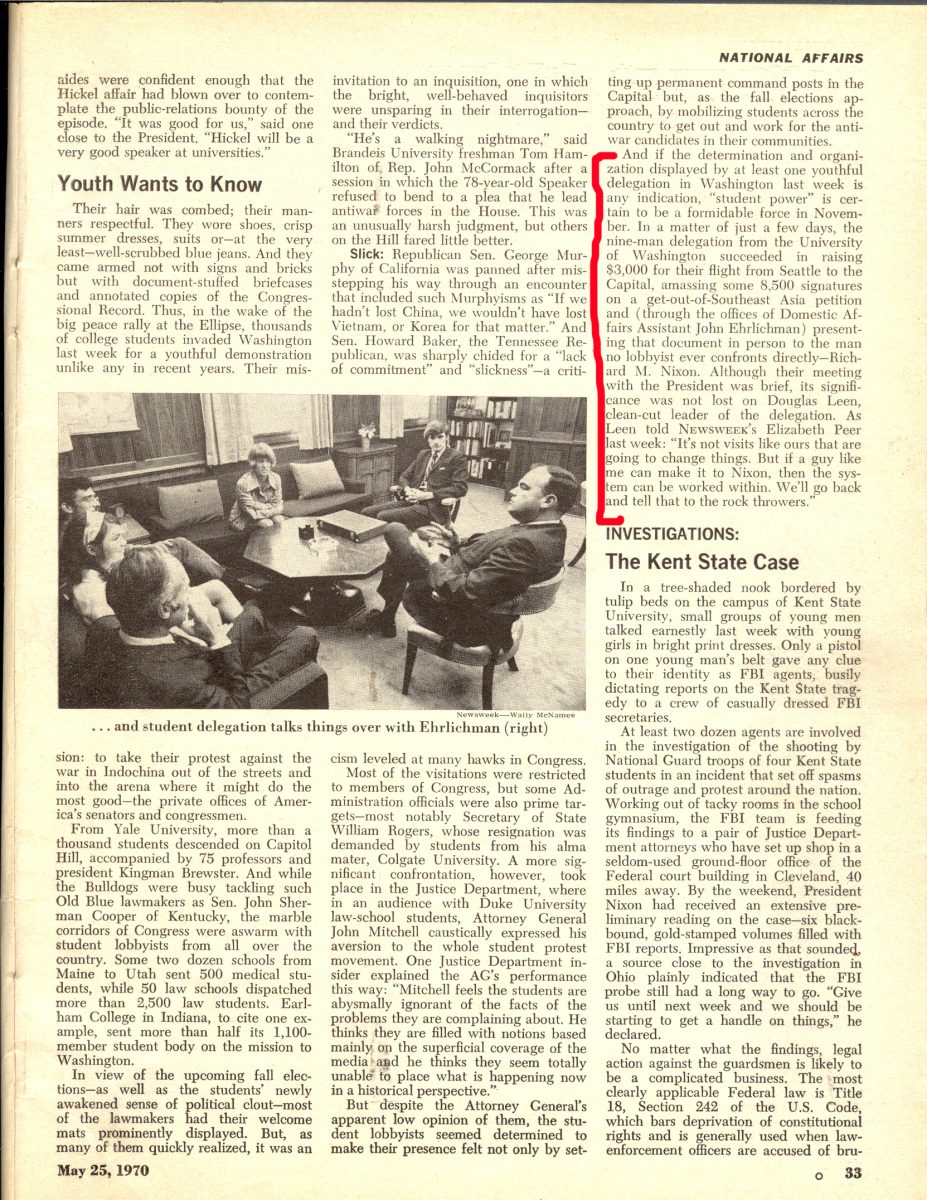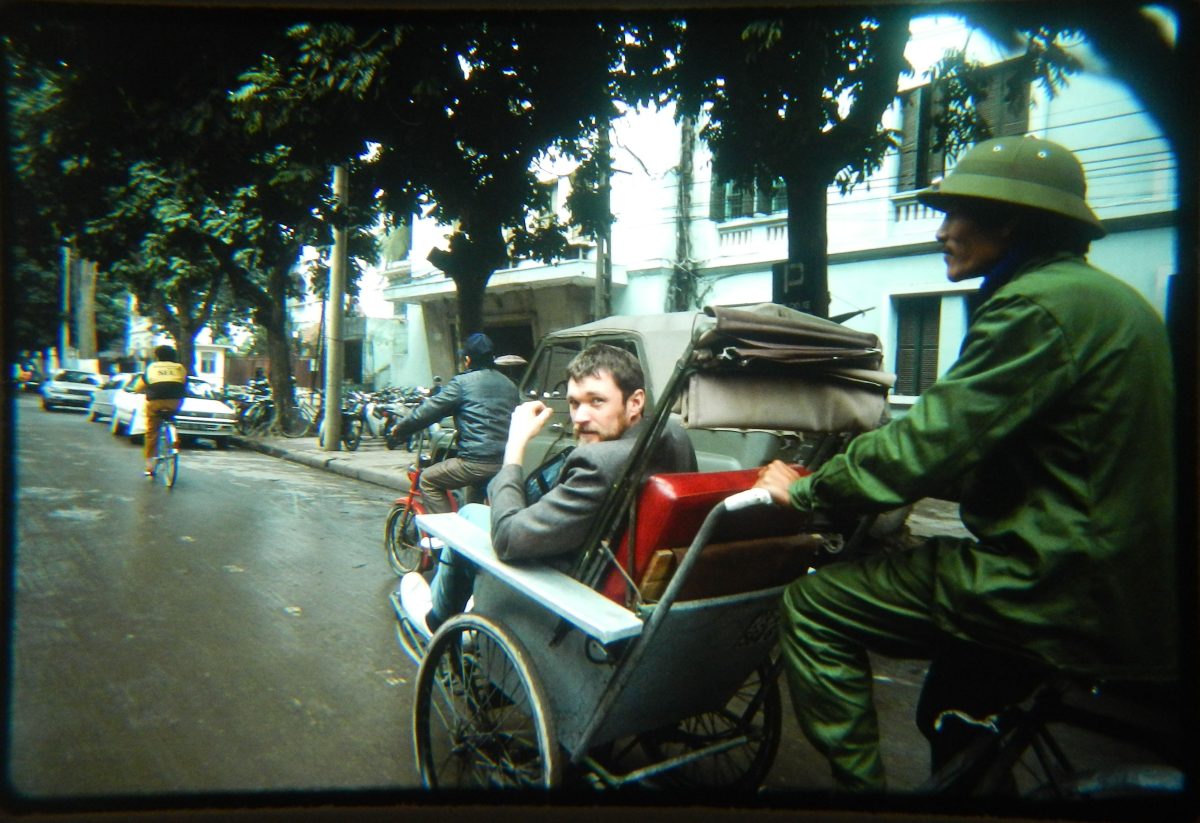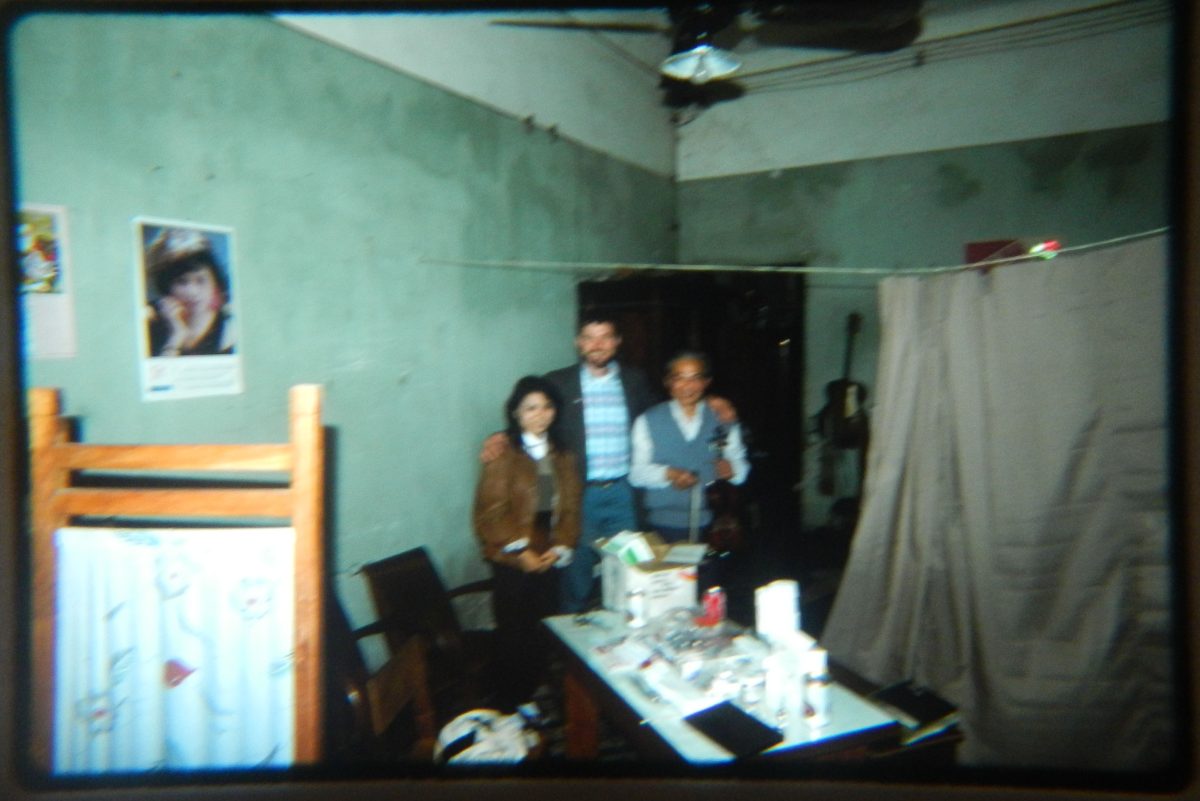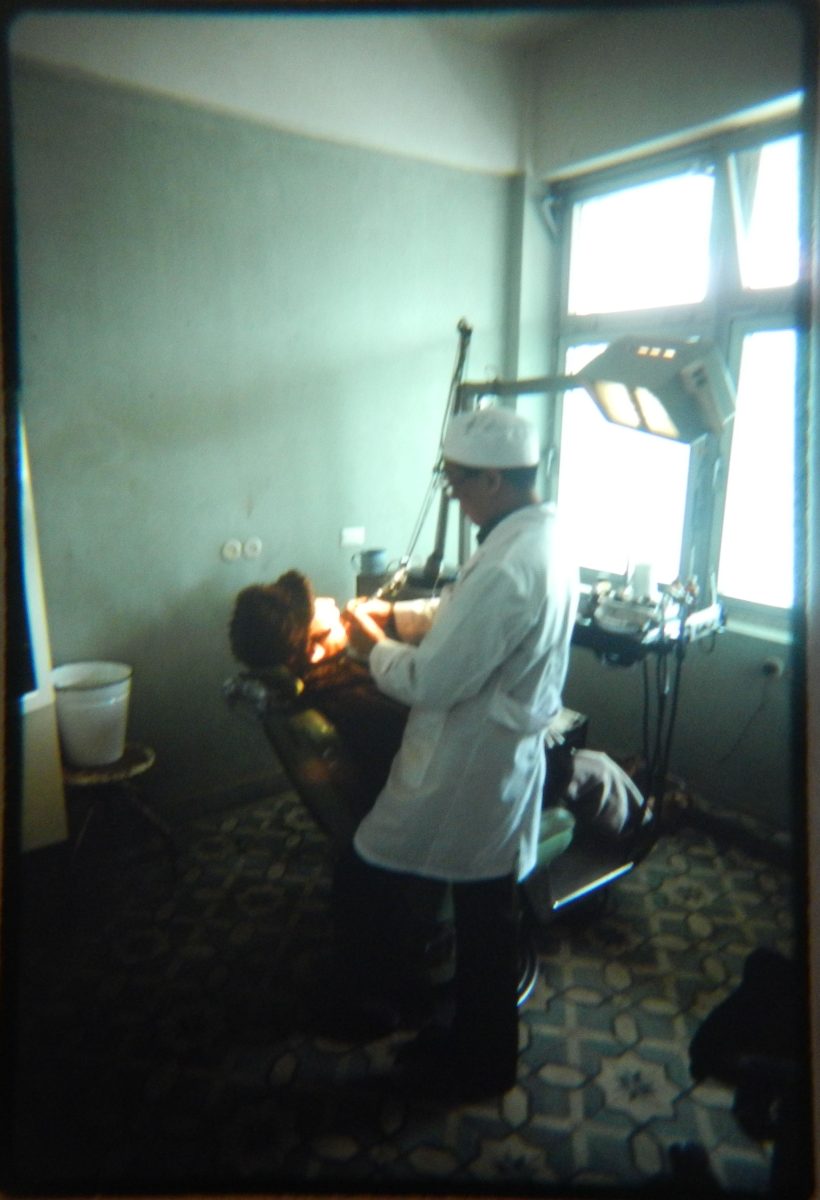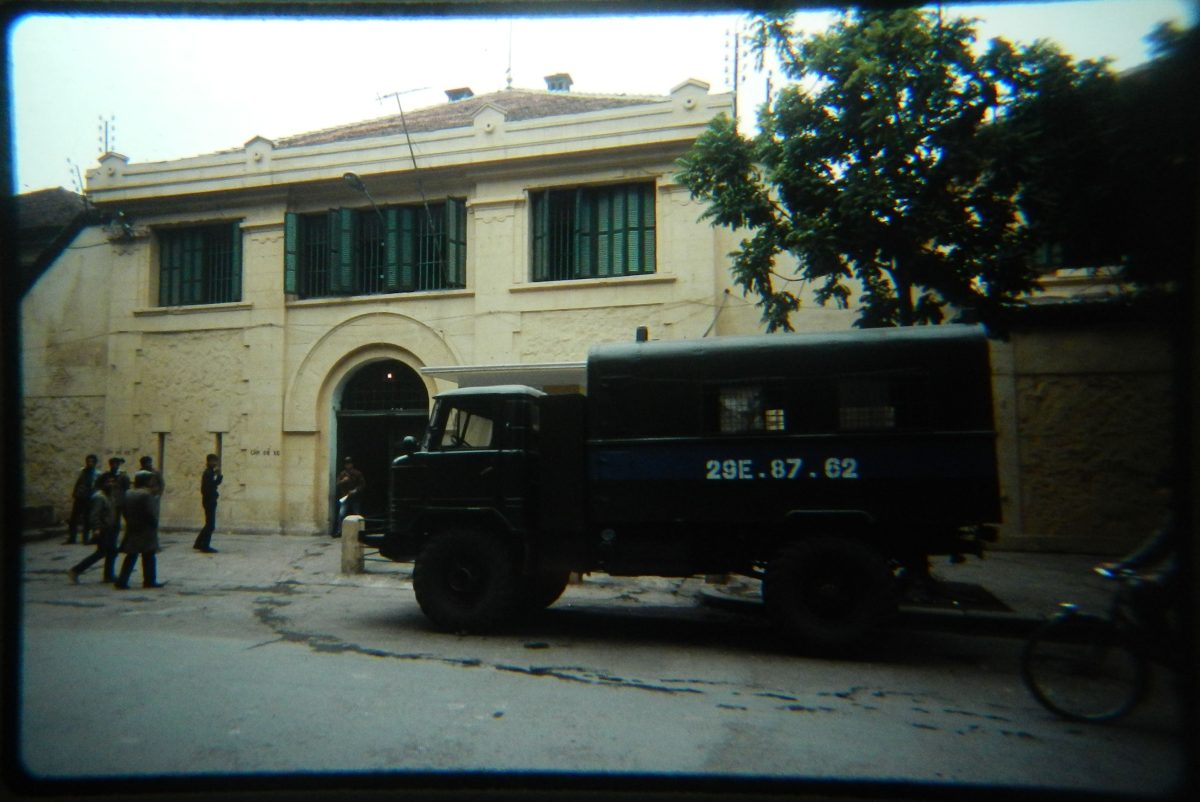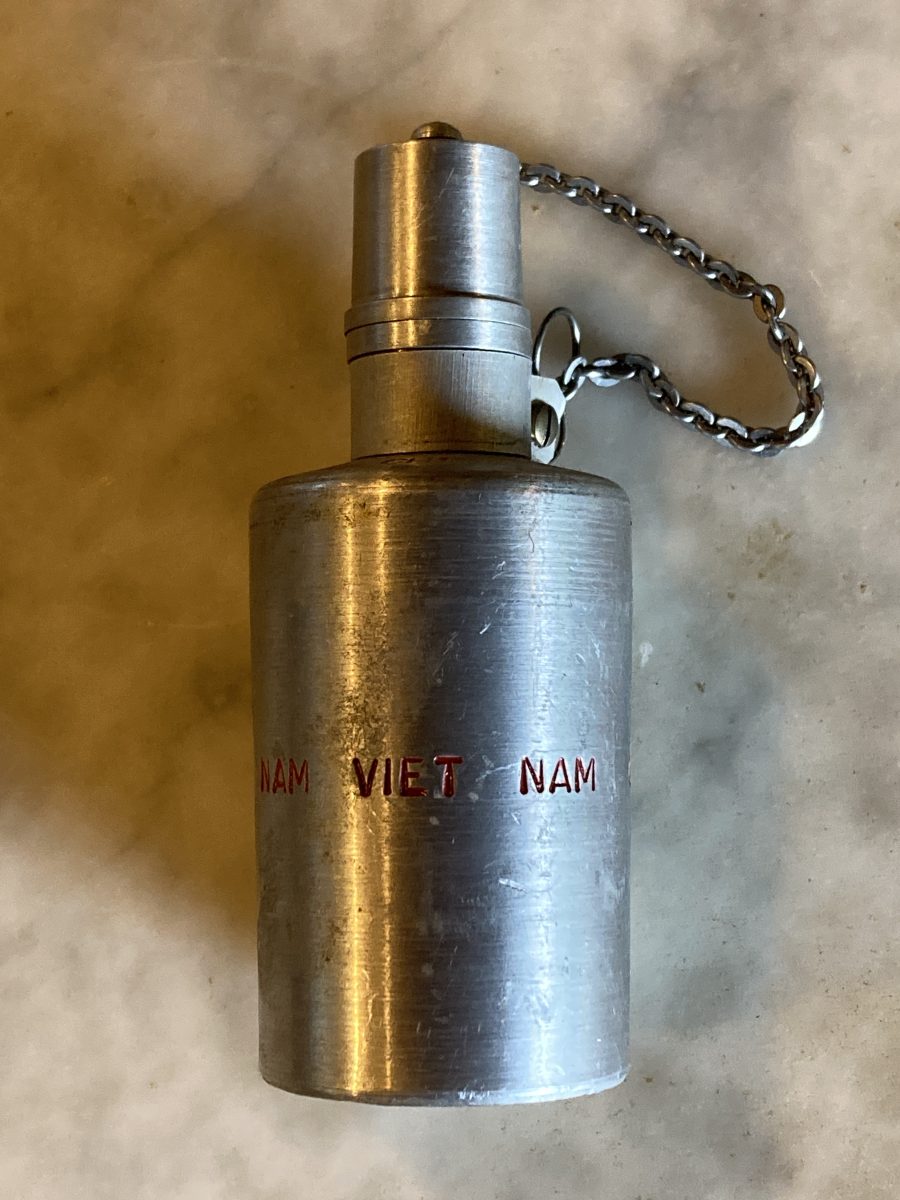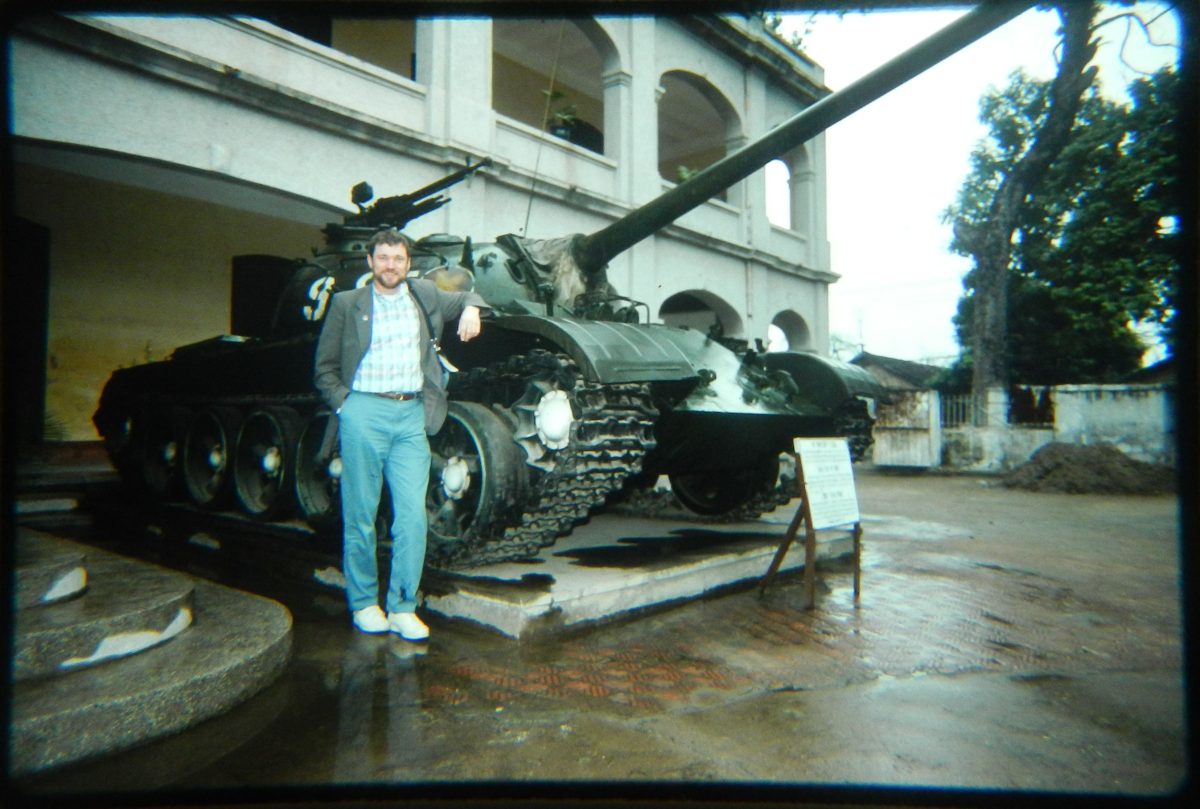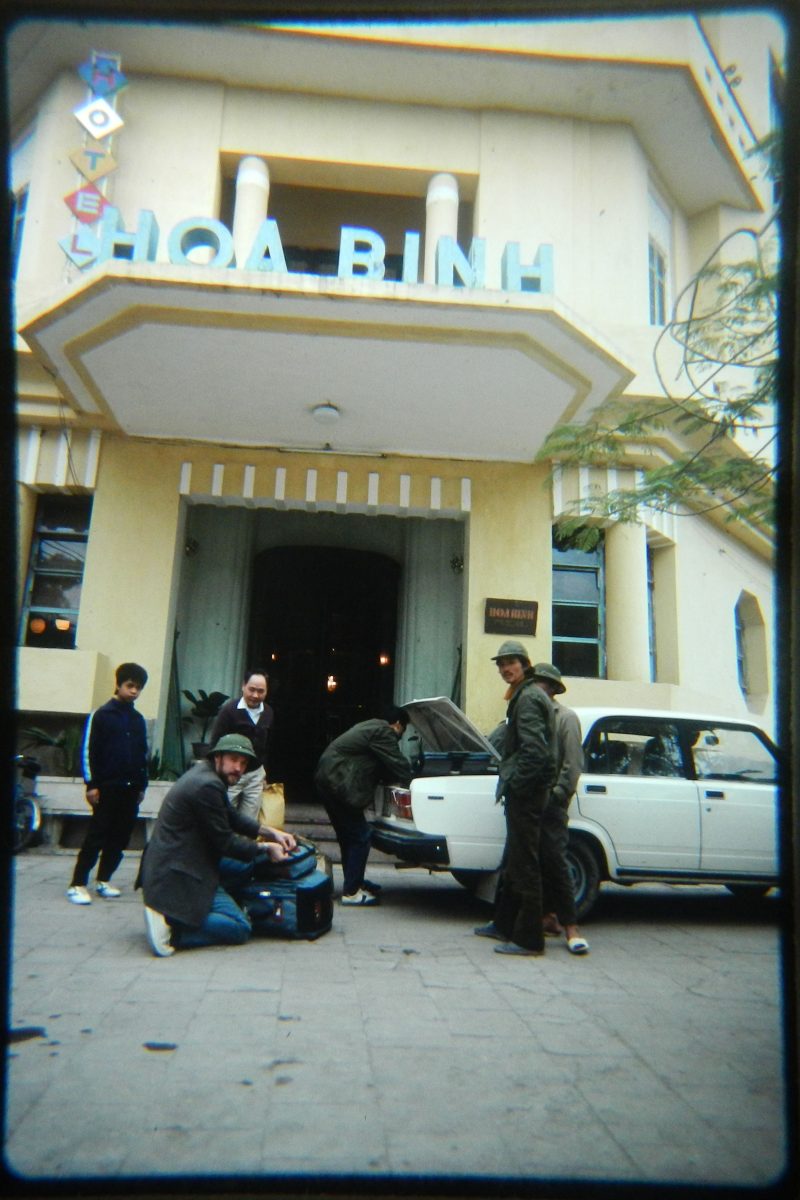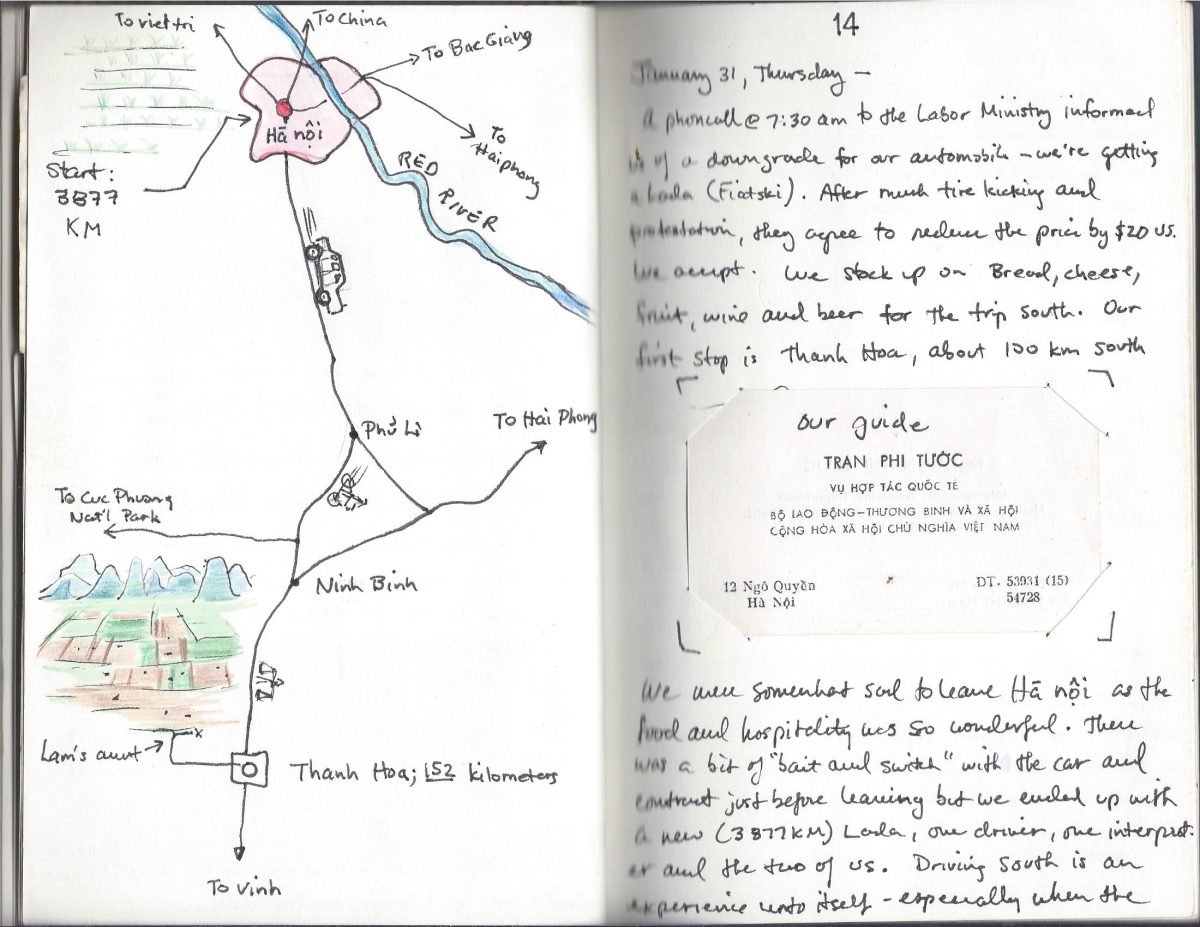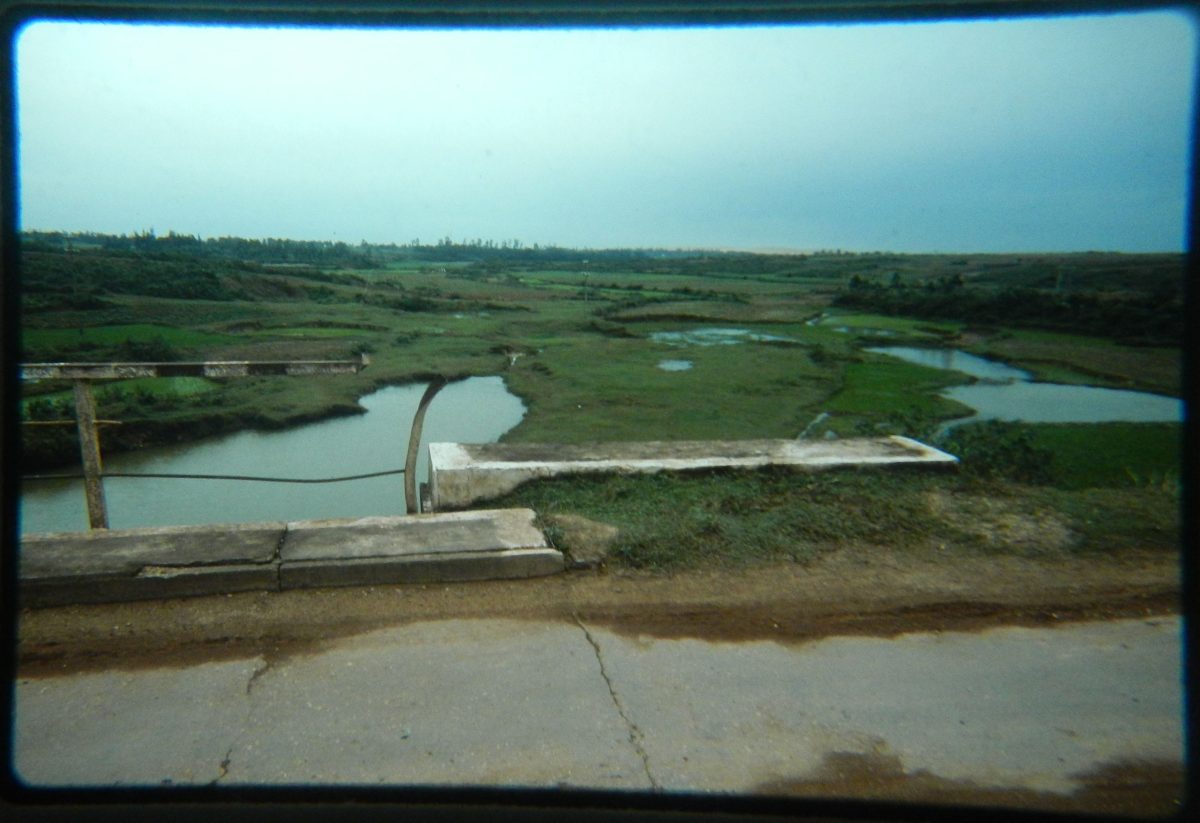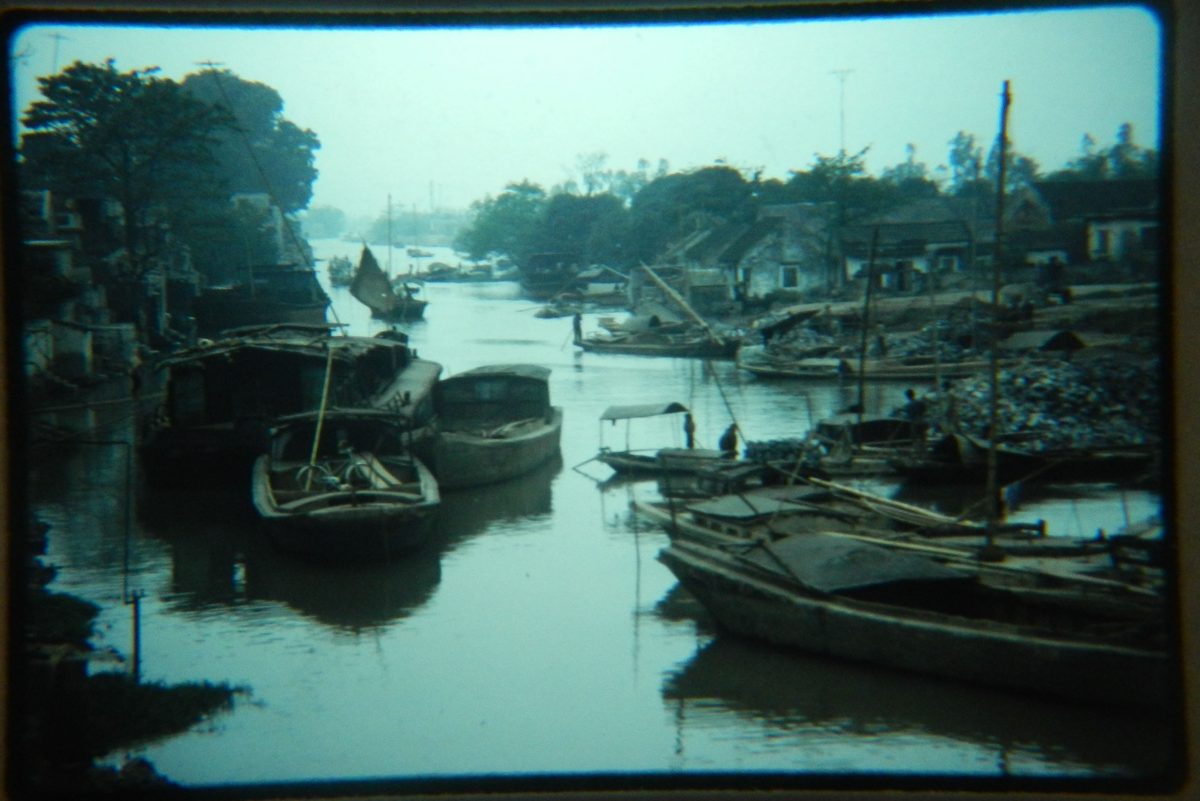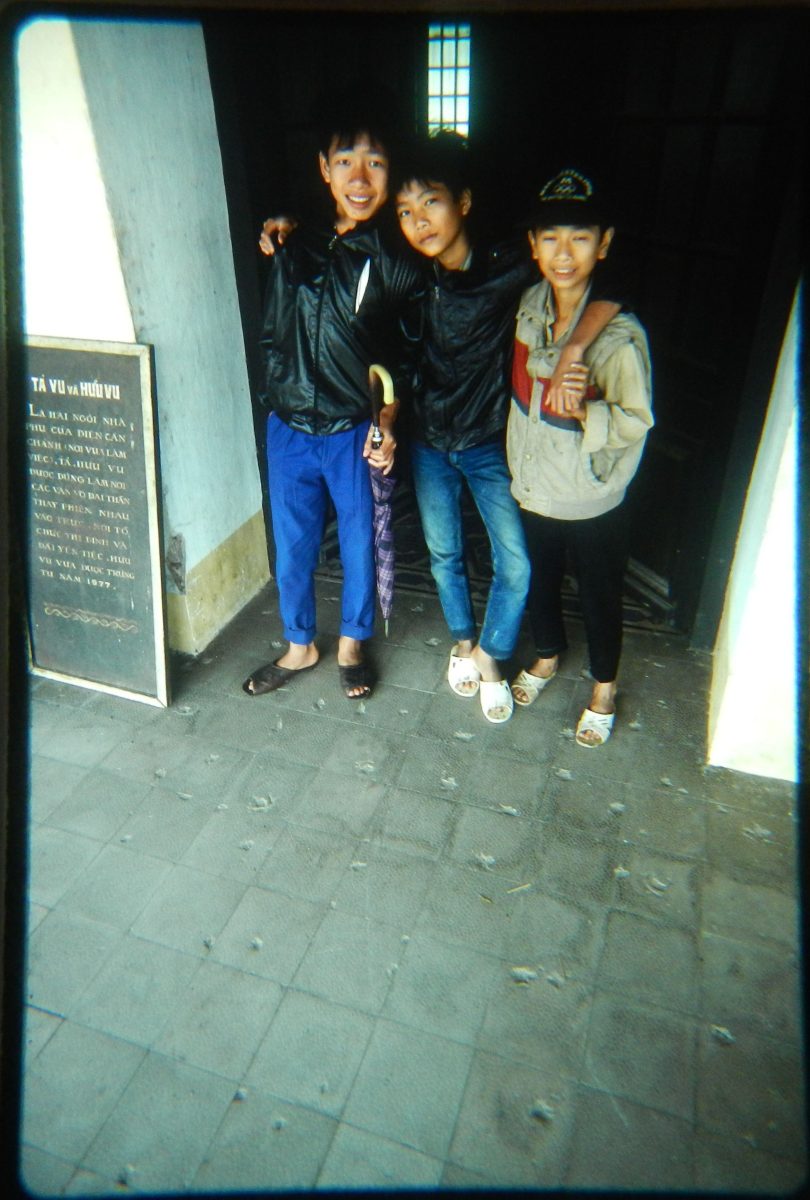This photo was taken by White House photographers on the 14th of May, 1970 or thereabouts on the Rose Garden Veranda at the White House with “you-know-who.” I’m on the left and was leader of this group of four–“The Seattle Four” as we called ourselves. It was now just over three years since I had returned from Vietnam and just less than a year since my complete discharge. So, how did I get here?
After my active duty, my first order of business was to set up basecamp at home and get some transportation. I needed to take stock of my finances–Navy Auto Sales and fleeced me out of car and a limited college fund that an uncle had left me mysteriously disappeared. I first got a job at my old digs–now called Mayfair Markets where I worked in the Nursery. I bought a used VW–for $1200–it was two years old. Then I attended Everett Junior College where I filled out the basics before matriculating at the University of Washington in the Fall of 1967–I had just turned 21. The Navy still had a purchase on me–reserve meetings which would take another 2 years and be a thorn in my side. I toughed it out first at the Naval Reserve Training Center, now MOHAI (built by the WPA!) on South Lake Union, and then at Sand Point Naval Air Station (now Magnuson Park). My final service date would be October 13, 1969.
Minor military duties aside, I first moved back home and of course, the neighborhood had changed. This is the house I grew up in from 1949 to 1963. It was built in 1936–a cheap farmhouse–uninsulated and with one oil heater. After the freeways pushed through Juanita (and “eminent domain” half our property), we turned the house around with this ugly remodel. Jillions of cars roared by–124th was now an onramp to I-405. With this “progress” came crime and to solve the crime, they put up mercury-vapor street lights. I tolerated this for six month of this, then moved back to the quiet–downtown Seattle near the UW. Gotta mention this–My boss at Mayfair one day asked me to drive a gentleman back to his house–that he was too old to walk back uphill the one block–so I obliged:
I put this in here because Carl Yttregard was 104 year old! He was born in Norway in 1862 (during our Civil War), left home on a whaling ship for the Philippines and was chased by cannibals. He was married four times and outlived them all including all his kids. He loved whiskey and always tried to get me drink some–but I had to get back to work. He came to Seattle in 1899–the year my house and my tugboat were built (a coincidence). What history he told. Found this photo with the rest and had to share–here on a weekend excursion up to Snoqualmie Pass–he hadn’t been out of Seattle for years.
In the fall I matriculated at the University of Washington and took up residence in a house with 7 other mountain climbers in a house called Wilbur’s Alpine Club.
Wilburs was started in 1944 by a taxi cab driver who loved the mountains. My rent was $27/month but I had to cook one night each week for the rest. Every climber in Seattle eventually lived here or joined our dinner table. This house still stands but Wilburs is long gone.
Here’s a little glimpse of college life in the 1960s: Wilburs was on 20th NE two blocks from the “U”–the tower in the distance was the campus boundary. My VW is on the left. Life began to get normal and it got even better with dorm parties and something completely missing in Vietnam–girls. Like most college students, we had our parties. Marty McCallum, a Wilbur’s resident liked to throw parties–here we roast a sheep, Arabic style after removing the back yard fence (inviting the neighbors, of course). I think about 600 people eventually showed up–I forget exactly. Marty and I are left in the left photo with some of Marty’s Arab friends. Marty still fishes in Alaska and stops by my house here in Alaska en-route through the Wrangell Narrows.
At the UW, I met a Swedish foreign exchange student and we pal-ed around for a year mostly climbing and skiing (and partying). At that same time I met legendary climber Fred Beckey….. Another influence on me was a UW professor, Giovanni Costigan–who was a vociferous anti-war speaker. I began to read the history of our involvement in Vietnam. I spent every spare moment I could in the mountains.
Here, Fred (foreground) and college chum Greg Donaldson and I pause to catch our breath at the Index Town Wall where we did a few routes.
Squamish Chief, British Columbia, climbing the Dike Route. This was big stuff! I learned a lot from Fred–we knocked off a fantastic line on the South Early Winter Spire here–perhaps my finest climb. I was taking intensive Russian then and cut up my book to lighten my load up this face–I studied as I belayed. Fred thought I was crazy, but then, I knew he was. The road was being built across the North Cascades and Fred surmised, correctly, that he had better get the jump on these routes before the road was completed. We had to walk 20 miles up to the base of this massif–Liberty Bell Mountain. Our routes went up both edges–like bookends. Here, Fred is on the summit of the South Spire (left)
I met Fred at Eric Bjornstad’s Coffee House–they were popular at the time and we’d hang out in the evening, sip coffee, listen to a local guitar solo and chat. Eric wallpapered his Coffee House–called Eigerwand–with Austin Post aerial photographs of mountains. Austin was a USGS photographer and glacial expert in the footsteps of Brad Washburn. Beckey would peruse through all his mountain photos for likely alpine routes. One rainy night at the Eigerwand, a gaunt “old man” came through the door of the Eigerwand. He had a stern look and headed in a beeline to the back kitchen. I remember he had huge crevices in his cheeks that you could drive a piton into. This was our childhood hero, Fred Beckey. I’ll leave it to modern search engines for anyone who is curious–there is a upcoming book on Fred due out by The Mountaineers. Eric was a character also–I had entered a different world–certainly one different than my previous two years camping out in Vietnam and the clean, white t-shirts and crewcuts of the early ’60s. My early climbing was pounding up volcanoes (I did them all summer & winter) and Rog & I planned a trip up McKinley after I returned from Vietnam–it never happened. Four years climbing with Fred took me all over–Wyoming, Canada and of course, the North Cascades.
Back in Seattle–the Seattle Skyline in 1966–the Space Needle was the tallest ‘building’ and was only three years old–I have the very tip-top of the Needle sitting my fireplace mantel to this day…..but that’s another blog–snitched on a dare after another perilous climb.
This is perhaps my most memorable climb–an easy winter ascent of The Tooth, near Snoqualmie Pass. I had met Tom Hornbein in 1963 directly after he returned from Mt. Everest–he traversed the West Ridge with Willie Unsoeld, descending the South Col in what is still today, the greatest mountaineering feat of all time. I would hitch rides with him to Mt. Rainier where I was working on the Camp Schurman summit hut. Tom’s in the center here. Ted Wilson (left)–whom I met at UW was a guide for John Harlin at Leysin Switzerland (see this post for more). Ted was three term mayor of Salt Lake City and was a wonderful life-long friend. He skippered my 73′ 125 year old tug up to Alaska…..and back! On the right is Dick Emerson, also of the 1963 Everest Expedition. I was in good company! All are gone now–so enjoy your friendships while you can!
The UW before they ripped up the Quad and installed Red Square. I majored in Geology ultimately, after wandering through dozens of hallways and auditing classes. Here’s how that came about: My first year was completed in the Spring of 1968 and then the GI bill was approved by Congress and signed into law. It wasn’t much but it did provide me with about 18 months of income at about $125/month. I had to spend it wisely so I went down to the advisors and they recommended testing to see what I was good at. Well–this process took about 6 weeks–the industrial psychologist in charge of the program decided to give me the entire battery of tests. In the end, I sat down with her and asked what I was going to be when I grew up. “You’re going to be a dentist!” she exclaimed with absolute certainty. I fell off my chair–“the furtherest thing from my mind” I replied. She pointed out all my high scores and said to apply. The line was 1000 people long and I felt somewhat intimidated, plus I had little science…..but all my initial prerequisites were satisfied so I had two years to ponder this. Meanwhile, on her advice, I wandered around campus and audited a few classes. One day I was in the basement of Johnson Hall and there were photographs of mountains everywhere and ice axes in the corners…..climbing boots nearby. I tapped a student on the shoulder and asked: “What department is this?” “Geology,” he replied. I became a Geologist. Sort of…..I never so much as swung a geology hammer, instead bought a piton hammer and joined the mountain rescue team at Grand Teton National Park. But, I’m getting ahead of myself.
So…..the Spring of 1970 all hell broke loose on most campuses around the country. Nixon was President and he invaded a neutral country adjacent to Vietnam–Cambodia. Then, four peacefully protesting, unarmed students at Kent State University were gunned down by our own National Guard. Another nine were wounded. I grabbed a roll of computer print-out paper (a wide, perforated folding paper for computers–and an endless scroll for my petition) and put a card table up in front of the Husky Union Building (HUB) and four days later I had 10,000 signatures, running over 300′ long with three columns of signatures. Two faculty members came up to me and asked me to represent the University on a trip to Washington. I accepted.
This is the first page of my petition–my signature is #1 on this list. Note initially I had written “5” killed….changed to “4”. That fifth person was Tom Grace–whom I would later make acquaintance with on the 50th anniversary–precipitated by a retrospective article in the NY Times written by Richard Perloff. Tom spent 7 weeks in intensive care but survived.
So off we went to the White House and got in, through the good graces of Professor Kermit Hanson (Dean of the School of Economics) whose daughter, Kathy, accompanied us. He knew John Ehrlichman (left above) who was the Domestic Advisor to Nixon and along with Haldeman, Kissinger, and McNamara were the architects of the Vietnam War–these are the people I needed to chat with. We first met with Ehrlichman and he spent about 3 hours with us and kept asking to see the petition I held–and I wouldn’t give it to him. I informed him that it was addressed to the President and we wanted to hand deliver it. He swung around to his phone and after a few minutes, said to follow him–parking us in the West Wing. After a few more hours of waiting, we were told we had 15 minutes with the president. We walked out to the veranda next to the Rose Garden. There a helicopter was parked and everyone was bustling about. Ehrlichman told me under no uncertain terms, “Do not hand that petition directly to the President–Ron Ziegler is up-tight!” (Ron Ziegler was Press Secretary) and gave us the evil eye throughout this meeting. Of course, I handed it to Nixon and Ehrlichman stepped in and grabbed it–here is that moment.
Here is the Seattle Times article:
….and Newsweek Magazine. They called me ” Clean-cut Leader of American Youth.” which I put on all my resumes! Spring 1970 was my last quarter in college and I was absent for 5 of the 10 weeks. The UW went “Pass-Fail” so I approached all my professors begging for a “Pass” and got them. In spite of my absence in class (memorizing the glacial epochs of the world), I had likely learned more; albeit in political science. Meanwhile, I had applied for two USGS jobs: one in Alaska doing mineral assays and a second option was mapping the Quaternary geology of Yellowstone! I couldn’t decide on which…… and as things turned out, took neither.
On spring break just before my Washington DC trip, I had driven down to Jackson Hole to do some skiing–it had a new ski resort and I’d stop in Sun Valley, Alta, and Snowbird, then drive up to Jackson. I got to Salt Lake City and camped out with Ted Wilson. Then the phone rang, and it was Fred Beckey……Ted deferred the call to me (he had papers to grade) so I spent most of that week camping in Monument Valley and Arches National Park climbing in the cold, windy desert. We got nothing done and hobbled back into Salt Lake City where Ted and I went up for a quick couple days of skiing. There, Ted quit his NPS job and handed it off to me. What luck! So, I became a Jenny Lake Ranger, got married, returned to Dental School (prodded by Tom Hornbein who visited) and set up a dental practice in Seattle’s Pike Place Market. I also built a cabin in Jackson–with a chainsaw and a rented horse with logs purchased from Laurance Rockefeller hisself–but that’s another blog…… In Seattle, I got involved with several civic boards including Seattle Chamber Music Festival (now Society) and the Pike Place Market Merchant’s Association. I was asked to run for mayor (no kidding). I also signed up for Sister City exchanges with Russians (I took intensive Russian at the UW)–and found myself hosting all sorts of interesting folks….
One group I hosted was the half-time entertainment for the World Cup Soccer match–the Soviet Amputee International Soccer champs. After their stay, we were expected to by them some trinkets to take home–like off-shore electronic gadgets. We balked and decided to take them down and buy them new legs–those that could accept them. Dr. Ernie Burgess was a prosthetic physician and had invented a CAD-CAM device to mill a socket directly from reading a leg stump and could produce a leg in about 2 hours. To this he attached his famous “Seattle Foot.” He had bundled this contraption in a large van and wanted to take it to Hanoi to replace limbs that we had blown off in the war (most amputees, we found later in a study, had lost limbs to land mines in the Kampuchean (Cambodian) War with Pol Pot). Burgess found out I spoke both Vietnamese and Russian (Russia was where most Vietnamese doctors were trained) and was familiar with dental prosthetics, etc. and invited me along. So, back to Vietnam I went–it was 1989.
Hanoi in 1989 was still a back-water recovering from the “American” war. The population of Vietnam in the late 1980 was now nearly 78M people and the average age was only 17–there was virtually no memory of the war in the population. I teamed up with an Ephrata WA potato farmer, Len Nichols, and we flew into Bangkok as an “advance party” after detouring all around the Pacific–6 days before our departure, G. W. Bush decided on the worst foreign policy faux pas in American history (after Vietnam) and invaded Iraq. Bangkok has a significant Muslim population and sitting in an ex-pat bar, drinking beer and eating cashews, we watched US bombs again dropping on dubious foreign targets. Outside, a few bombs went off in protest–shear lunacy. Here I am 25 years later sitting in Bangkok–where I took my first R&R–awaiting to fly in the reverse direction, into Hanoi where it was relatively safe. Oh, the irony of it all. Len was an amputee also and stored a motorcycle in Hanoi. He and I would ride about–him with his prothesis sticking straight out like Joseph Goebbels! We first went over to the Australian Embassy and they gave us pointers to navigate around Hanoi. We all went out for dinner that first night and I’ll never forget the food–Crab Farci (a French dish of twice baked crab) and Beethoven! Two young Vietnamese girls dressed in the traditional ao dai came in–one with a violin–and played a Beethoven violin sonata. Two giant woks glowed on purple and orange charcoal below staring down through the central mezzanine–a Nat Geo moment.
My host in Hanoi was actually the gentleman on my left here; Bac Si (Doctor) Bui Tung. He was a physician in Hanoi and had served in both the French and American wars amputating limbs–about 10,000 of them. He was at Dien Bien Phu when it fell. He spoke fluent French–walking around in the early morning in Hanoi, everyone was out doing Tai Chi and down near the Red River, you could smell French bread baking every morning–I thought I was in Paris. After retirement from Hospital 108 in Hanoi–the government hospital there– Dr. Tung simply set up a private practice in the Cha Ca district of Hanoi (Fish Markets–like the Pike Place Market in Seattle where I practiced). We were kindred spirits–this defiant act rankled the Communist Party in Hanoi but they needed physicians. He was pestered by patients with dental problems and heard that I was coming over and could I bring a few items. Absolutely. I went down to my supplier–Patterson Dental–and pleaded my case for some huge discounts. The manager there had served in Chu Lai about a year after me–and I walked out with about 300# of equipment–anything a dental surgeon could imagine. Of course, an x-ray wouldn’t penetrate this box and caused problems when I boarded in Seattle (to Bangkok). Well Bac si Tung (his surname was Bui) was beside himself and asked what he could do in exchange. I saw a violin on his clinic wall and asked him if he played it? Of course, he replied, so he took it down and played a short Bach partita. A class act!
As an additional favor, Bui Tung set up a meeting with his old colleagues at Hospital 108 and introduced me to his brother, Bui Dai, who was the head administrator of the hospital. He brought the head dentist, Nha Si Pham Van Mui (Nha Se is Dentist). Here–the dental clinic–1920s Czech equipment. Dr. Mui was Ho Chi Minh’s dentist. We scrambled for a common language none of us guests spoke French and none of them, English but we broke through this language barrier when I asked Dr. Mui where he studied dentistry. He replied; “Leningrad.” I immediately switched to Russian and off we went–with an invitation for Mui to be my guest back in Seattle at the annual American Dental Association Convention. Immediately Dr. Dai agreed with the clap of his hands. Amazing! And we waged over 10 years of war with these gracious people. They arranged a short tour around Hanoi–including the “Hilton” and a B-52 which crashed into one of the lakes in the city center. Here is the “Hilton” then a prison.
This is where John McCain spent 5-1/2 year of his life and with a broken arm. I could not imagine. I attempted to walk in but was told to leave. Today, there is a modern Hilton hotel on this site. The B-52 site was also impressive with the plane augured in at an odd angle (as I recall). Locals had set up a small industry there making souvenirs from the fuselage or old artillery casings. One “trinket” I picked up were a couple of table kerosene lamps–quaint items to enjoy a romantic dinner over—made of old hand grenades! I slipped these in my luggage and continued my trip—all the way home–with no one caring I carried a couple of ‘hand grenades’ aboard airplanes. I would travel from Hanoi to Saigon, to Singapore, Darwin Australia, then circumnavigate Australia, then Hawaii, than back-track to the Marshall Islands working on a hospital ship (Tole Mour) and finally returning back to Hawaii and Seattle. Not once was I questioned about these.
Here’s my lamp. I have two of them.
Another stop was the War Museum. This is the tank that rolled through the US Embassy gates in 1975 ending the “American” war. Persistence.
Outfitted in my Viet Cong helmet, Lam (my hotel acquaintance) and I pack in front of the Hoa Binh hotel readying for a trip south. This was a trip worthy of a separate post–and in fact, I wrote an illustrated diary of this trip at the time–a page of which is here:
Lam, who traveled independently was an attorney practicing in Bothell Washington–the next town from where I grew up (Juanita Beach). He was visiting Vietnam to reconnect with this family–some living in the north and some in the south. He had rented a ‘black market’ car and paid up front for this no-so-legal trip. I met him in the Hoa Binh lobby–he heard my stumbling Vietnamese and Russian and offered to translate. We both wanted to travel to Saigon and fly out of there. He told me that this Volga car that he had “rented” was actually a gov’t car and they guy was moonlighting. I don’t know how a guy can moonlight with a government car and take two Americans (my passport was confiscated when I arrived) 1800 kilometers to another city without being detected. I inspected this Volga and it couldn’t have made it out of town. The bottom line–the gov’t got wind of this crazy idea and stepped in abruptly–I was like a deer in the headlights. “What do you want to do?” they asked. We stammered and stuttered that we simply wanted drive down their entire country and sight-see……and they agreed but scolded us for not going through official channels. They said we would be provided with a British Land Rover and could leave within a few days. We were flabbergasted. But, it was “bait & switch” as we ended up with a little Lada–the Russian “Fiat-ski” as they were called. Fiat’s weren’t of the best of reputation and a Russian copy made me nervous, but it was brand new. Two drivers (a guide Tran Phi Tuoc) went with us and off we went.
Crossing every bridge south of Hanoi we encountered all these bomb-craters–obviously bridges were targets during the American War. The Vietnamese fixed these bridges overnight and then ran fish-ponds in the resulting lakes created by the bombs. We also stopped at every graveyard–there were dozens and crosses as far as the eye could see. They guides were instructed to stop at each.
A river crossing. Lam and I stayed a few days in Hue where most of his family lived. His relatives took is in and planned a huge feast–it was nearing Tet, their New Years. Vietnam was at war with China then (they always are at war with China) but they stopped the hostilities and opened the borders up so beer could be transported across for Tet. We feasted! And what a family–all the girls gathered around and wanted me to send them perfume and US trinkets when I returned. Their father, a Tai Chi instructor was a most gracious host–his house was filled with meritorious awards and photos in all sorts of Tai chi poses. His mother was shot and killed by US Marines during a lock-down just before the American War ended, when she tried to dash between two houses. What I found among peoples of both the north and south (it is now one repatriated country for those who haven’t followed the politics) there was absolutely no animosity towards Americans–and in other ways they still admire us. It was a rather humbling experience. At a Hanoi dinner–with all senior gov’t officials–I asked one official why they didn’t harbor bad feelings towards us. He replied as rather nonchalant that they simply won the war and we had lost and that was the end to it. They wanted to look ahead to their future.
I’m not an historian, nor a writer (as I state in my recent book “Ranger of the Lost Art–Rediscovering the WPA Poster Art of our National Parks–which can be seen at www.rangerdoug.com), but here is a very simple history of our interactions with the Vietnamese:
After WWII, and after kicking out the Japanese, who had invaded not only Vietnam, but China, Burma, Thailand and half of the Pacific Islands, the Vietnamese under leadership of Ho Chi Minh (their George Washington) wrote a letter to Harry Truman asking to be included in America’s sphere of influence. Americans had allied with the Chinese to defeat the Japanese in their country also and Uncle Ho naturally assumed that Truman would be proud of the Vietnamese for doing the same–and single-handedly. Truman never saw the letter as the CIA intervened and destroyed it. Within 6 weeks after VJ (Victory over Japan), the US assisted France to capture all the armories in Vietnam and French colonialism was back on track with the US paying 80% of the budget. Both Truman, Eisenhower, Kennedy, Johnson and Nixon would follow this same line of foreign policy–one of the worst decisions every made in American history–and ending with a resounding defeat.
The Vietnamese are fiercely independent people. They are also very smart, very clever and very industrious. They are also very persistent. And, I might add, they are very proud. And for a thousand years (or more), they have defended themselves from China. In short, Vietnam would have been the perfect ally for the US in Asia and Truman blew it. Colonialism was on the way out after WWII (Read King Leopold’s Ghost’s by Adam Hochschild–for the last disastrous attempt). The Vietnamese were simply sick and tired of colonial rule–first by Germany, then France and now the United States. Uncle Ho thought this would be a diplomatic marriage made in heaven but he underestimated the stupidity of American foreign policy. All we could see was a domino theory. The Viet Minh began a guerrilla war immediately, ending in 1954 with the surrender of French at Dien Bien Phu. It was a Tortise and Hare defeat and humiliating for France but the US, having “invested” heavily in this folly, was more worried about the “communist menace” than the freedom of the Vietnamese to dictate their own destiny. We both could have achieved our goals–a non-Communist Vietnam and a staunch ally, not to mention about 2 million lives.
The CIA, polled the 1956 election probabilities and realized that Uncle Ho would win over corrupt puppets dominating in the south; US puppets, (the Bao Dai) and a Catholic 10% minority. Geographically, Vietnam is like an hour glass–with the political power residing in the north (Hanoi) and the economic power residing in the south (Saigon). This contributed to a political dichotomy. After the French defeat, elections were to be held within two years but this, of course, was sabotaged by the CIA so the Viet Cong (southern version of the Viet Minh) emerged after digging up their weapons and beginning yet again. This time they would face American forces. Military advisors were first sent in and free economic zones and “safe” villages were established–all failing. Adding to this dichotomy, the Catholic 10% controlled the Buddhist majority. In 1963 Ngo Dinh Diem (pronounced Ziem) and his brother Nhu were assassinated and it went downhill from there. American’s premise of “liberating” Vietnam was dead-wrong: Robert McNamara, Kennedy’s Secretary of Defense, former Ford Motor Company President, reasoned, wrongly, that all he needed to do to accomplish his goals was to throw more soldiers into the war effort. After employing Napalm, Agent Orange and carpet bombing of the North, world opinion turned against the US. We were fighting against people fighting for their homeland and we know that never works. One by one, the provinces fell to the northern armies and by 1973 the US, like the French, departed in disarray and disgrace with over 58,000 war dead. We clapped our hands and imperiously stated that we had accomplished our goals and that the ARVN (Southern forces) could now defend themselves. The South fell like dominoes–just like our theory had predicted. But now, the Vietnamese were truly independent and self ruling after 100 years of colonialism. People will argue with me that this isn’t freedom, but I would argue that it is more free than the puppet regimes installed by their colonial overlords. And I predict, that some day, the Vietnamese will liberalize to a hybrid form of government and become a world power and more closely ally with the United States. We’ll see. Visit Vietnam if you haven’t.
PS: I will be continuously editing these three narratives.

